


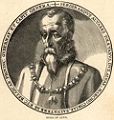
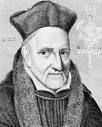
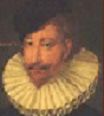










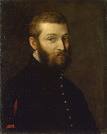


1580 There is an earthquake in London; new bldgs. are banned to restrict growth of the city. On Jan. 31 King-Cardinal Henry (Henrique) I (b. 1512) dies, leaving no heir (he wants to admit to?), and the Avis (Aviz) Dynasty in Portugal (founded 1385) ends (in with a Henrique, out with a Henrique?), causing the Portuguese secession crisis of 1580; in June old fart "Iron Duke" Fernando Alvarez (Álvarez) de Toledo y Pimentel, 3rd Duke of Alva (Alba) (1507-82) and a 40K-man army of Spanish troops along with German and Italian mercenaries land in Portugal, meeting a ragtag 8.5K-man Portuguese army along with 3K African slaves at the Aug. 25 Battle of Alcantara near Lisbon, which is captured on Aug. 27, after which Henry I is succeeded by Philip II (the Prudent) of Spain (1527-98) after six other less rich claimants are dealt with, esp. Duke John of Braganza (1543-83) (grandfather of Joao IV), and crowned next Mar. 25, founding the House of Hapsburg (Philippine Dynasty) in Portugal (ends Dec. 1, 1640), ruled by three Spanish Hapsburg kings named Philip, while the Spanish under the cruel-is-cool pain-no-problemo Duke of Alva crush all opposition; Philip II now rules the original empire in which the Sun never sets, taking the title of richest ruler in history (there's a crime in every fortune, to the nth power?); Ceuta reverts from Portugal to Spain; the annexation of Portugal vastly increases Spain's already formidable naval fleet. And now England's ass is grass and he's got the lawnmower? Pope Gregory XIII reissues his predecessor's bull against the excommunicated heretic bastard Queen Elizabeth I, and Philip II begins planning the Enterprise of England (Roman Catholic invasion); meanwhile the pope sends English Jesuits (St.) Edmund Campion (1540-81) (who had once been a top Protestant cleric in line for archbishop of Canterbury, then "took a remorse of conscience and detestation of mind" in 1569 and ended up fleeing to Douai, France in 1571 and converting) and Robert Parsons (Persons) (1546-1610) (an Oxford don who had fled in 1574) to England to aid in undermining Elizabeth, and on June 24 Campion arrives in London pretending to be a jewel merchant, but when he finds they know his identity he begins openly preaching to Catholics while eluding capture, causing Queen Liz to become antsy while he plays the Jesus-in-Jerusalem part; meanwhile Parsons flees to Spain and plots with Philip II to invade the stankin' infidel English and finish them off; by this year there are 100 Roman Catholic seminary priests in England, who are usually hidden in "priest holes" in Catholic homes, causing experienced priest hole finders to case them in order to make them say prayers from the Anglican Book of Common Prayers to expose them to heresy prosecution when they refuse, causing the nursery rhyme Goosie Goosie Gander to be created; "Goosie goosie gander,/ Whither shall I wander?/ Upstairs and downstairs/ And in my lady's chamber./ There I met an old man/ Who wouldn't say his prayers;/ I took him by the left leg/ And threw him down the stairs" - don't just look smart, play smart? In Jan. after Muslim religious leaders object to it, Sultan Murad III orders the destruction of the astronomical observatory in Constantinople. On Feb. 7 a UFO is sighted in the Atlantic Ocean off Magallanes, Chile. On Mar. 5 James VI raises recently-returned (from France) Esme (Esmé) Stewart (Stuart) (1542-83) (cousin of his father Lord Darnley) to 1st earl of Lennox, followed next Aug. 5 to 1st duke of Lennox, and he converts from Roman Catholic to Protestant to please the king and silence rumors that he is an agent for the Counter-Reformation; meanwhile rumors spread about their suspected love affair - after all, my mommy is about to give head at Fotheringay? On June 11 Spanish conquistador Juan de Garay (b. 1528) (who got his rival Jeronimo Luis de Cabrera executed in 1574) leads an expedition from Asuncion and refounds Buenos Aires (1st time 1536); too bad, on Mar. 20, 1583 he is ambushed and killed on the banks of the Carcarana River by Querandi (Querandí) natives, inventors of the bola. In June England signs the English-Ottoman Commercial Treaty with the Ottomans (ratified in Constantinople on May 3, 1583), giving England privileges formerly limited to France and Venice; it is renewed through 1675. On Aug. 30 Emmanuel Philibert (b. 1528) dies while trying to acquire the marquisate of Saluzzo, and his only son Charles Emmanuel I "the Great" (1562-1630) becomes duke of Savoy (until 1630), going on to try to recover lost territories Geneva, Montferrat, and Saluzzo, flip-flopping between alliances with Spain and France and ending with little gained and the French overruning his Italian-speaking Turin-based duchy. On Sept. 10 after being secretly sent by Spanish king Philip II and financed by Pope Gregory XIII, Spanish ships under command of Adm. Don Juan Martinez de Recalde (1540-88) land 600 Italian-Spanish freelance soldiers supporting the Desmond Rebellion commanded by Sebastiano di San Giuseppe (da Modena) in Smerwick on the Dingle Peninsula (westernmost point of Ireland/Europe); meanwhile 4K men East of their position led by Lord Desmond, John of Demond, and Lord Baltinglass attempt to link up with them for supplies, but are blocked by English forces under the 10th Earl of Ormond and Arthur Grey, 14th Baron Grey de Wilton (1536-93), new lord deputy of Ireland (until 1582), while English ships under Richard Bingham blocked Smerwick Bay, causing the papal forces to retreat to the nearby Fort of Gold (Slaughter) (Dun an Oir); on Nov. 7-10 the English stage the Siege of Smerwick (Ard na Caithne); when the papal forces surrender they are summarily executed under de Wilton's orders. On Sept. 26 after crossing the Pacific to the East Indies, Francis Drake (1543-96) arrives in Plymouth, England, becoming the 2nd man to lead a round-the-world voyage (36K mi.) (began 1577); the queen gives him a green silk scarf, but rumors of his pirate habits eventually take the shine off, and the queen keeps 20% of his £800K treasure haul. On Nov. 19 in a fit of insane rage, 50-y.-o. Russian tsar Ivan IV the Terrible (b. 1530) strikes and kills his son and heir (tsarevich) Ivan Ivanovich (b. 1554) with his iron staff - you can't please everyone so you got to please yourself? On Dec. 30 after being plotted against by the duke of Lennox and his companion James Stewart, earl of Arran, Scottish regent James Douglas, 4th Earl of Morton (1516-81) is deposed for his part in the murder of Lord Darnley, and he is executed next June 2 on the Scottish Maiden, which he introduced to Scotland; the regency now belongs to whomever has custody of the king, who is warmly in the hands of Esme Stewart. The Venetians import coffee from Turkey; in return tobacco arrives in Turkey and Poland; European tobacco cultivation begins in Cuba. Portugal and Spain send reinforcements to the Philippines to protect the Portuguese traders and missionaries in Cambodia; meanwhile the Dutch work in secret with natives in Jambi, Sumatra to corner pepper production. The British navy introduces the rank of lieutenant (lt.) (pr. LEF-tenant) (Fr. "holding in lieu of") as an asst. to the capt. who is qualified to relieve him. St. Peter Canisius leaves Germany and founds the Jesuit Seminary of St. Michel in Fribourg, Switzerland, which evolves into the U. of Fribourg. A stud farm for 16-hand small-headed pure white silky-coated Lipizzaner (Lipizzan) Horses is founded in Lipizza (near Trieste) from stallions presented to Maria Theresa by the Jerez Monastery in Spain, who kept their bloodlines pure after they were originally bred from Roman and Moorish stock to fight the Moors. Lodovico Carracci (1555-1619) and his cousins Agostino Caracci (1557-1602) and Annibale Carracci (1560-1609) found the eclectic Bolognese School of Painting, synthesizing the best elements of the other Italian styles, founding landscape painting as an art form, and collaborating on painting projects for the next decade, incl. the Palazzo Ghisilardi Fava (1582), Palazzo Magnani (1577-83), and Farnese Palace in Rome (1597-1604). Jan Sweelinck becomes organist at Dude Kerk in Amsterdam. The last miracle play is performed in Coventry, England. Architecture: English architect Robert Smythson (1535-1614) begins the Elizabethan-style Wollaton Hall near Nottingham (finished 1610), becoming a prodigy house, "the architectural sensation of its age". Nonfiction: Jean Bodin (1530-96), De la Demonomanie des Sorciers (Of the Demon Mania of the Sorcerers); pleases the public with the assertion that an accusation of witchcraft (pact with the Devil) is almost always true, and nobody can be erroneously condemned if the correct torture procedures are used, even on children? Francois de la Noue, 24 Discours Politiques et Militaires; pro-Huguenot. Johann Fischart (1547-90), Das Jesuitenhutlein; anti-Jesuit. Michel de Montaigne (1533-92), Essays; incl. the meaty On Cannibals, waxing lyrical over the "noble savage"; "What a stupid thing is an old man learning an alphabet." (II) Bernard de Palissy (1510-89), Discours admirables, de la nature des eaux et fontaines, tant naturelles qu'artificielles, des metaux, des sels et salines, des pierres, des terres, du feu et des maux (Paris); applies ancient Alexandrian principles of hydraulics, and incl. a theory of the origin of springs and underground waters, enunciating the modern theory of the origin of fossils. John Stow (1525-1605), The Chronicles of England (1580-92). Art: The Valois Tapestries, a series of eight tapestries depicting festivities of the French royal court are made in the Spanish Netherlands in this decade. Tintoretto (1518-94), Christ at the Sea of Galilee (1575-80). Paolo Veronese (1528-88), Wisdom and Strength. Poetry: Fernando de Herrera (ed.), Poetry of Garcilaso de la Vega. Jan Kochanowski (1530-84), Threny (Polish laments). Music: Richard Jones, A Newe Northen Dittye of ye Ladye Greene Sleves (Sept.) (London); "a new courtly sonnet of the Lady Greensleeves"; doesn't stop the myth that Henry VIII composed it; mentioned by Shakespeare. Births: Belgian (Flemish) physician-scientist ("Founder of Pneumatic Chemistry") Johann (Jan) Baptista (Baptist) van Helmont (d. 1644) on Jan. 12 in Brussels; disciple of Paracelsus; coiner of the term "gas". French soldier-poet-dramatist Honorat de Bueil, Seigneur (Marquis) de Racan (d. 1670) on Feb. 5 in Aubigne-Racan, Sarthe. English courtier (gay?) William Herbert, 3rd Earl of Pembroke (d. 1630) on Apr. 8; son of Henry Herbert, 2nd earl of Pembroke (1534-1601) and Mary Sidney Herbert (1561-1621); brother of Philip Herbert, 4th earl of Pembroke (1584-1649);royal chamberlain 1615-25; lord steward 1626-30; chancellor of Oxford U. 1617-30; namesake of Pembroke College, Oxford U.; patron of Ben Jonson and Philip Massinger; Shakespeare's secret lover in 1597-1609?; Shakespeare's "Sonnets" are inscribed to "Mr. W.H."; Shakespeare's First Folio is dedicated to the "Incomparable Pair of brethren". French priest (St.) Vincent de Paul (d. 1660) on Apr. 24 in Guyenne, Gascony; captured by Turkish pirates in 1605-7. German mathematician Johann Faulhaber (d. 1635) on May 5 in Ulm. Dutch Renaissance scholar-poet Daniel Heinsius (Heins) (d. 1655) on June 9 in Ghent. Dutch Snell's Law mathematician-astronomer Willebrord Snell (Snellius) (Willebrord Snel van Royen or Roigen or Roijen) (d. 1626) on June 13 in Leiden. French Vernier scale mathematician Pierre Vernier (d. 1637) on Aug. 19 in Ornans, Franch-Comte. Spanish poet-writer-statesman Francisco Gomez de Quevedo y Santibanez (Santibáñez) Villegas (d. 1645) on Sept. 14 in Madrid. Italian surgeon-anatomist Marco Aurelio Severino (d. 1656) in Nov. in Tarsia, Calabria; student of Tommaso Campanella in Naples. French astronomer Nicolas-Claude Fabri de Peiresc (d. 1637) on Dec. 1 in Belgentier, Var. German Thirty Years' War Protestant gen. Count Ernst von Mansfeld (d. 1626); illegitimate son of Count Peter Ernest von Mansfeld. English "A Chaste Maid in Cheapside" Jacobean playwright-poet Thomas Middleton (d. 1627) in Apr. in London; educated at Queen's College, Oxford U.; collaborator of William Rowley (1585-1626); only dramatist other than Shakespeare who can write both comedy and tragedy. Romanian Calvinist king of Hungary (1620-1) and prince of Transylvania (1613-29) Bethlen Gabor (Gabriel Bethlen) (d. 1629) in Marosillye. English adventurer-explorer ("America's first rebel") Capt. John Smith (d. 1631) in Jan. in Willoughby (near Alford), Lincolnshire; founder of Jamestown (1607). English Jacobean "The Duchess of Malfi", "The White Devil" dramatist John Webster (d. 1635) in London; last of the great Elizabethan playwrights. Dutch gov.-gen #3 of the New Netherlands (1626-31) (Protestant) Peter (Pieter) Minuit (Minnewit) (d. 1638) (b. 1685?) in Wesel, Cleves (modern-day North Rhine-Westphalia, Germany) - and he drives a great bargain too? Dutch "Laughing Cavalier" Dutch Golden Age portrait-genre painter Frans Hals (d. 1666) (b. 1582?) in Antwerp, Flanders. Deaths: English dramatist John Heywood (b. 1497) in Mechelen, Belgium: "The moon is made of a green cheese." Chinese novelist Wu Cheng'en (b. 1500); leaves the novel Journey to the West. Italian High Renaissance architect Andrea Palladio (b. 1508) on Aug. 19. Portuguese king-cardinal (1578-80) Henrique I (b. 1512) on Jan. 31. Spanish historian Jeronimo Zurita y Catro (b. 1512) on Nov. 3 in Saragossa. German dramatist-poet Heinrich Knaust (b. 1520) on Nov. 7 in Erfurt. Portuguese poet Luis Vaz de Camoes (Camoens) (b. 1524). English horticulturist Thomas Tusser (b. 1524). Italian duke of Savoy (1553-80) Emmanuel Philibert (b. 1528) on Aug. 30 in Turin. English historian Raphael Holinshed (b. 1529). Spanish chess champ Ruy Lopez de Segura (b. 1540). Russian tsarevich Ivan Ivanovich (b. 1554) on Nov. 19 in Alexandrov; killed by his daddy Ivan IV the Terrible.




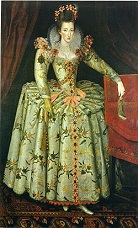




1581 On Mar. 18 Parliament passes a Revised Statute of Recusancy, making conversion to the Roman Catholic faith tantanount to treason in England; over the next 20 years 250 Catholics are executed or die in prison. On Mar. 23 English maid of honor Anne Vavasour (1560-1650) secretly bears the Earl of Oxford's illegitimate son Edward in the Maidens' Chamber, and he refuses to marry her, but Elizabeth I makes him pay her £2K, banishes him from court, and imprisons him for several mo. in the Tower, then banishes him from court until June 1582; meanwhile he reconciles with his wife Anne Cecil in Jan. 1583; during her reign she approves 18 marriages for her maids. On June 27 400 copies of the pamphlet Decem Rationes (Ten Reasons) by pesky English Jesuit (St.) Edmund Campion (1540-81) are found in the pews of St. Mary's in Oxford, causing a sensation, and on July 14 he is arrested in Lyford, Berkshire and taken to London with a sign on his hat reading "Campion, the Seditious Jesuit"; after the queen personally offers him wealth and titles if he gives up that Catlick stuff, he refuses and is hanged, drawn, and quartered on Dec. 1 for treason, but not before new official censor (a learned poet) Thomas Norton (1532-84) (known by English Catholics as the "Rackmaster General") uses his favorite toy on him three different times; too bad, rabid Calvinist Norton later slips into Puritanism and is thrown in the Tower, released, then dies of ill health in 1584. On Sept. 8 a 31K-man Polish-Lithuanian army under Polish king Stephan Bathory invades Russia and begins the Siege of Pskov, defended by 16K men under Prince Ivan Shusky, forcing the Russians to cede Livonia on the Baltic; on Sept. 6 the Swedes recapture Narva; the town of Pskov remains unconquered. On Sept. 11 the English Levant (Turkey) Co. receives a royal charter to trade with the Ottomans as a monopoly (ends 1825). On Oct. 31 the Duke of Anjou returns to England to woo Elizabeth again; she promises to marry him formally on Nov. 22, then waffles and finally rejects him, using him as a tool to hold off Spain from attacking. In Dec. Walter Raleigh (1552-1618) is sent to England with dispatches, and attracts the queen's favor, allegedly by placing his embroidered cloak on a puddle of water so she can pass over it dry-shod, and becomes her favorite, receiving large estates and becoming one of the wealthiest men in England, getting knighted in 1584; meanwhile Elizabeth I knights Sir Francis Drake (1543-96) in Deptford - watch the ear? The seven Dutch provinces within the Union of Utrecht (Guelders, Holand, Zeeland, Utrecht, Overijssel, Frisia, Groningen and Ommelanden) proclaim their independence from Spain, founding the Repub. of the Seven United Netherlands (Provinces) AKA the Dutch Repub., United Provinces, Federated Dutch Provinces, and Dutch Federation (ends 1795). Fear of restoration of Roman Catholicism in Scotland causes the Gen. Assembly of Scotland to denounce the pope and Roman Catholicism in emphatic language, ratify the Nat. Covenant (King's Confession), drafted by John Craig (Gael. "rock") (1512-1600), and force James VI to sign it; its signatories and adherents become known as Supplicants. James VI raises the earl of Lennox to duke (the only duke in Scotland); rumors that they are lovers and that he has too much influence with the king stink up the court? The Russians double the size of their territory by taking control of the Tartar Khanate of Siberia (1581-98) via Cossack hetman Ermak Timofeev, becoming the sole achievement of Crazy Ivan IV since his wifey croaked in 1560. Morocco under sultan (1578-1603) Ahmad I al-Mansur (1549-1603) begins expanding across the Sahara Desert, targeting the gold-rich Songhai Empire of W Africa. Peruvian viceroy Francisco de Toledo sends a military expedition to the Inca hideout of Vilcabamba, captures Inca (chief) Tupac Amaru, and executes him. Spanish explorers probe N along the Rio Grande River into New Mexico, and do it again in 1583. Spanish Capt. Ivan Sabala leads 100 soldiers and their families to Cagayan in NE Philippines to explore the Cagayan Valley, convert the natives to Roman Catholicism, and settle; in 1583 the entire NE are of Luzon Island is organized into the Province of Cagayan. Pope Gregory XIII attempts to reconcile the Roman Catholic Church with the Russian Orthodox Church. 17-y.-o. Christopher "Kit" Marlowe (1564-93) becomes a divinity student at Benet (later Corpus Christi) College at Cambridge; he leaves before taking Anglican orders to become a playwright, writing his first play Dido, Queen of Carthage (debuts in London in 1587-1593) (which contains suspiciously homoerotic scenes?), and joining London's entertainment industry, which is always looking for good scripts? - I like the nightlife, I love to boogey? Collegio dei Raxonati is founded in Venice, becoming the first prof. assoc. of bookkeepers (accountants). Matteo Ricci (1552-1610) and Lazzaro Cattaneo (1560-1640) become the first Roman Catholic missionaries sent to China. Architecture: A cylindrical column topped by a pelican is erected in Corpus Christi College, Oxford U., becoming its symbol. Inventions: The Scots begin using the Scottish Maiden, a head-cutting machine with horizontal blades (until 1685), while the Germans in this cent. begin using a similar machine called the Dolabra. Sedan chairs come into use in England. Science: With clocklike precision, Italian scientist Galileo Galilei (1564-1642) discovers that the time taken by a swinging lamp in the Cathedral of Pisa does not depend on the angle through which it swings (i.e., a pendulum swings isochronously). Nonfiction: Thomas Watson (1557-92) (tr.), Sophocles' Antigone. Music: Balthazar de Beaujoyeux, Le Ballet Comique de la Reine (5+-hours long); the first ballet for which a complete score survives; performed in Paris before Henry III and his court in honor of a royal wedding in a decorated palace hall, helping to make Paris a center of ballet - how can a 50-y.-o. grandmother look this good, simple? Plays: George Peele (1556-96), The Arraignment of Paris (pastoral); performed before Queen Elizabeth I; pub. anon. in 1584; contains the poem Oenone's Complaint. Nonfiction: Cardinal Robert Bellarmine (1542-1621), Polemic Lectures Concerning the Disputed Points of the Christian Belief Against the Heretics of This Time (1581-93); disses the Lutherans who preach that the papacy is the Antichrist, claiming that it will be a single individual in the future (AKA Jesuit Futurism); Protestants don't buy it until Samuel Roffrey Maitland (1729-1866) comes along, then a bunch of them bite bigtime, right Hal Lindsey? Theodore Beza (1519-1605), Histoire Ecclesiastique des Eglises Reformes au Royaume de France. William Borough, A Discourse on the Variation of the Compass or Magneticall Needle. Coroso, Il Ballerino. Vincenzo Galilei (1520-91), Dialogo della Musica Antica e Moderna. Stefano Guazzo, Civil Conversations (tr. George Pettie). Richard Mulcaster (1531-1611), Positions Wherein Those Primitive Circumstances Be Examined, Which Are Necessarie for the Training Up of Children; advocates "footeball" (soccer) for students, and calls for the introduction of referees, containing the first pub. reference to teams ("sides" and "parties"), positions ("standings"), and coach ("trayning maister") - he's the king of reinvention? Robert Norman), The Newe Attractive; retired mariner pub. his independent discovery of the magnetic dip (first observed in 1544). Lancelot Popeliniere, Premier Livre de l'Idee de l'Histoire Accomplie. Art: Caravaggio (1571-1610), Martyrdom of St. Maurice. Births: Irish world-dating scholar and Anglican archbishop of Armagh and primate of all Ireland (1625-56) James Ussher (Usher) (d. 1656) on Jan. 4 in Dublin; educated at Trinity College, Dublin. Dutch poet-dramatist-historian Pieter Corneliszoon Hooft (d. 1647) on Mar. 16 in Amsterdam; son of mayor Cornelis Hooft (1547-1627). Italian "The Maiden and the Unicorn" Bolognese Baroque painter Domenichino (Domenico Zampieri) (d. 1641) on Oct. 21 in Bologna; pupil of Denis Calvaert (1540-1619); so slow and plodding he gets the nickname "Ox". English "The Wife" poet-essayist Sir Thomas Overbury (d. 1613) in Compton-Scorpion (near Ilmington), Warwickshire; knighted in 1608. Italian physician-anatomist Gasparo (Gaspare) Aselli (Asellio) (d. 1626) in Cremona; discoverer of the lacteal vessels. English mathematician Edmund Gunter (d. 1626) in Hertfordshire; of Welsh extraction; educated at Westminster College and Christ Church, Oxford U.; inventor of Gunter's chain (22 ft.) and Gunter's scale; coins the terms "cosine" and "cotangent"; discovers the magnetic variation of the compass. English adventurer Sir Robert Shirley (d. 1628) in Wiston, Sussex; 3rd son of Sir Thomas Shirley Sr. (1542-1612); brother of Sir Thomas Shirley Jr. (1564-1620) and Sir Anthony Shirley (1565-1635). Spanish "La Verdad Sospechosa" Golden Age #1 dramatist (hunchback) Juan Ruiz de Alarcon (Alarcón) y Mendoza (d. 1639) in Real de Taxco, Guerrero, Mexico. French Roman Catholic Jansenist theologian-monk (Abbot of Saint-Cyran) Jean du Vergier de Hauranne (d. 1643) in Bayonne; butcher father; educated at the Catholic U. of Leuven; co-founder of Jansenism with Cornelius Jansen (1585-1638) and The Great Arnauld (1612-94). Italian Baroque painter Bernardo Strozzi (d. 1644) in Genoza. Am. Wampanoag (Mass.) chief (sachem) Massasoit ("supreme leader", "great sachem") (Owsamequen) (Woosamequen) of Pokanoket (d. 1661) in Bristol, R.I.; father of Metacomet (1639-76). Deaths: Spanish soldier-historian Diaz del Castillo Bernal (b. 1492). Scottish regent (of James VI) James Douglas, 4th earl of Morton (b. 1516) on June 2 in Edinburgh (executed on the Maiden, which he introduced to Scotland); leaves the unfinished Drochil Castle above the Lyne Water 6 mi. NW of Peebles in the Scottish Borders. Sir Thomas Wilson (b. 1524) (Elizabeth I's secy.) on May 20. English Roman Catholic priest St. Edmund Campion (b. 1540) on Dec. 1 in Tyburn (executed). German serial murderer Peter Niers (b. 1540) on Sept. 16 in Neumarkt in der Oberfalz (40 km from Nuremberg; convicted of 544 murders.
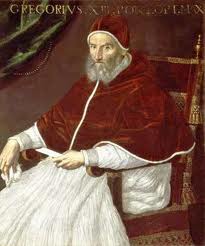
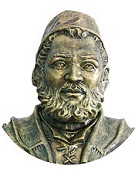

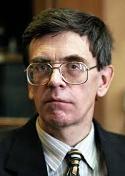






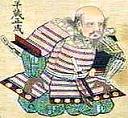
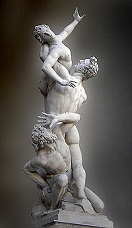
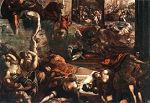

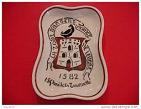
1582 On Feb. 7 frustrated in his marriage hopes by cagey Elizabeth I, Huguenot-friendly pockmarked French Duke Hercules Francois, Duke of Alencon (Alençon) and Anjou (1555-84) accepts an invitation from Lutheran leader William I the Silent, Prince of Orange (1533-84) (father of Maurice of Nassau) to become protector of the Netherlands; too bad, his attempts to secure absolute power piss-off everybody and get him expelled, and both die in 1584, letting everybody off the hook. On Feb. 24 upon the recommendation of German Jesuit astronomer Christopher Clavius (1538-1612), Pope (since May 13, 1572) Gregory XIII (1502-85) issues the bull Inter Gravissimas, decreeing a changeover from the Julian Calendar to the Gregorian Calendar; 10 days (lost since Jan. 1, -46, when the Julian Calendar began) are to be dropped, so that Oct. 15 (Fri.) immediately follows Oct. 4, or Dec. 20 (Mon.) follows Dec. 9; the Papal States, Spain, Portugal, and Poland change in Oct., France, Holland, Belgium, and Scandinavia in Dec.; the Roman Catholic states of Germany and Switzerland adopt it in 1584, followed by Hungary in 1587; too bad, Protestant countries suspect a rat and refuse to change, and the Continental Protestant states hold out until 1700, and England and its colonies till 1752; Russia holds out until 1918, Greece until 1924, and non-Euro states don't adopt it until the 19th and 20th cents., Japan in 1873, Egypt in 1875, Turkey in 1926, and China in 1949; the figure for the length of the year from Copernicus' De Revolutionibus Orbium Coelestium is proposed but not used as the basis of the reform calendar; after a suggestion by Vatican librarian Topo Gigio, er, Aloysius Lilius (Luigi Lilio or Giglio) (1510-76), only century years (1600, 1700, etc.) with the century part itself evenly divisible by four (1600 but not 1700) are leap years, which causes three leap years to be taken out of each 400, trimming the avg. calendar year down quite fortunately to only about 26 sec. longer than the Earth's real orbital period, which will take 3,323 years to become 1 day out of synch; too bad, there should have been a 13-day discrepancy, not a 10-day one, causing the Phantom Time Hypothesis to be developed by Herbert Illig (1947-), Anatoly Fomenko (1945-), Uwe Topper (1940-) et al., that phony phantom centuries were manufactured during the Renaissance to create a nonexistent Dark Ages; Pope Gregory's new calendar for the Christian world changes the date of the new year from Apr. 1 to Jan. 1, and those who still celebrate New Year's Day on Apr. 1 begin to be known as April Fools. On Mar. 4 Henry III of of Navarre (1553-1610) (later Henry IV of France) allegedly dines at the new Tour d'Argent (Silver Tower) inn in Paris (oldest Parisian restaurant to survive to modern times), discovers the fork being used by guests from Venice, and adopts it, his mommy Catherine de' Medici insisting that everybody use it; starting in the 19th cent. every diner who orders the house specialty canard rouennais (pressed duck in blood sauce) is given a momento ticket and recorded in a visitors' book; #112,151 goes to Pres. FDR, #203,728 to Marlene Dietrich, and #253,652 to Charlie Chaplin. On May 15 the Scottish ministry is informed that "the Duke [of Lennox] goes about to draw the king to carnal lust"; in July King James VI issues a proclamation ordering people to desist in spreading "such false bruits and manifest lies"; in Aug. a band of anti-Lennox Protestant nobles led by William Ruthven, 4th Lord Ruthven, 1st Earl of Gowrie (1541-84) stages the Ruthven Raid, kidnapping James VI and imprisoning him in the House of Ruthven for 10 mo. (until June, 1583), making him sign a document banishing his cousin Esme Stuart, duke of Lennox from Scotland as a suspected batter for the other team, er, agent for the Counter-Reformation; Lennox leaves for France on Dec. 21 - only time for the one chic mesh bag with the cordura on the sides? In May a Roman Catholic plot to overthrow Elizabeth I and put Mary Stuart on the English throne is hatched in Paris by the Guises, Pope Gregory XIII, Philip II of Spain, and the Jesuits; on May 30 after being tortured on the Scavenger's Daughter, English Roman Catholic priest Thomas Cottam (b. 1549) is hanged in Tyburn for high treason, and his mutilated corpse boiled in water to prevent Roman Catholics from using it for relics; the Jesuits in England gain one of their top martyrs. On Nov. 28 William Shakespeare (1564-1616) marries 8-year-older farmer's daughter Anne Hathaway (1556-1623) from nearby Shottery on the edge of the Forest of Arden (Lat. "burning for enthusiasm") ("William Shaxpere and Anne Whateley of Temple Grafton", according to the Nov. 27 episcopal register at Worcester); their children are Susannah Hall (nee Shakespeare) (May 1583-July 1649), and twins Hamnet Shakespeare (Jan. 1585-Aug. 1596) and Judith Quiney (nee Shakespeare) (Jan. 1585-1662). After Italian Jesuit papal legate Antonio Possevino (1533-1611) mediates, the 10-year Peace of Jam-Zapolski is signed, ending the Livonian War (begun 1558); Ivan IV the Terrible loses the Russian lands around the Gulf of Finland and on the W and N s hores of Lake Ladoga to Sweden; Sweden gets Estonia; Poland gets Latvia and Tartu; Russia loses access to the Baltic. Edmund Grindal is reinstated as archbishop of Canterbury by Elizabeth I. Japanese warlord Oda Nobunaga (b. 1534) is assassinated by one of his generals, Akechi Mitsuhide (1526-82); his other general Toyotomi Hideyoshi (1537-98) assumes control of his forces and kills Mitsuhide; samurai Hattori Hanzo (1542-96) saves shogun Tokugawa Ieyasu by leading him across Iga territory to his native Mikawa Province, becoming Japan's Robin Hood. The Venetian Constitution is amended to restrict the authority of the Council of Ten. The U. of Edinburgh in Scotland is founded, becoming the 6th oldest univ. in the English-speaking world. Utrecht Library in the Netherlands is founded. A Jesuit mission is founded in China. The English word "coffee" is coined from the Dutch word koffie, which comes from the Turkish word Kahve, which comes from the Arabic word qahwah. The English Royal Navy begins graduated pay according to rank. Louis de Gonzague (Gonzaga), Duc de Nevers (1539-95) visits sir Philip Sidney and John Dee in Oxford, England to discuss esoteric b.s.; next year Giordano Bruno visits Oxford and does ditto. Architecture: London's first waterworks are founded, and water wheels are installed on London Bridge. Alessandro Vittoria begins the Baroque Palazzo Balbi in Venice. Science: Urbain Hemand studies the anatomy of the teeth. Tycho Brahe builds a large triangular sextant with a globe mount at Uraniborg. Nonfiction: Anon., Life of St. Declan; about a 5th cent. Irish monk; the oldest surviving copy dates to this time. Robert Browne (1550-1633), Treatise of Reformation Without Tarrying for Any; by the first seceder from the Church of England, who tries to set up a Congregationalist church and dies in jail for assaulting a constable; used as a manifesto by the Puritans who found the Mass. Bay Colony. Giordano Bruno (1548-1600), De Umbris Idearum (On the Shadows of Ideas) (Paris); dedicated to Henry III; Ars Memoriae (The Art of Memory) (Paris); his system of mnemonics. George Buchanan (1506-82), Rerum Scoticarum Historiae (History of the Scottish Kings) (posth.); the purpose is to "purge" Scottish history "of sum Inglis lyis and Scottis vanite", pissing-off the govt., which recalls all copies to purge them of "offensive and extraordinary matters". English College of DDouai, The Douay (Douai) New Testament; English Roman Catholic trans. of the 5th cent. Latin Vulgate Bible, produced at the English College in Douai in N France on the Scarpe River, and pub. in Reims, France; the Old Testament follows in 1609-10. Alberico Gentili (1552-1608), De Legationibus Libri III (3 vols.); his first book on internat. law; De Juris Interpretibus Dialogi Sex. Richard Hakluyt (1552-1616), Diverse Voyages Touching the Discovery of America. Juan Ponce de Leon II (1524-91) and Antonio de Santa Clara, Relacion de la Isla de Puerto Rico; written in response to orders of Spanish king Philip II by Juan Ponce de Leon's son, who in 1579 became the first Puerto Rican-born gov. of Puerto Rico. Giovanni Antonio Magini (1555-1617), Ephemerides Coelestium Motuum. Richard Mulcaster (1531-1611), Elementarie; argues for teaching English instead of Latin, and for standardizing spelling; "I do not think that anie language... is better able to utter all arguments, either with more pith, or greater planesse, than our English tung is", although "forenners and strangers do wonder at us, both for the uncertaintie in our writing, and the inconstancie in our letters"; it ends with an 8K-word spelling list and a call for an English dictionary. Lancelot Voisin de La Popelinier (1541-1608), Les Trois Mondes; a history of the discovery of the globe, advocating French expansion in the "Third World" of the S hemisphere, now that North Am. has been lost. Art: Giambologna (1529-1608), The Rape of the Sabine Woman (1574-82). Tintoretto (1518-94), The Massacre of the Innocents (1582-7). Plays: Giordano Bruno (1548-1600), Il Candelaio (The Torchbearer) (comedy) (Paris). Births: Bohemian defenestrated nobleman (Roman Catholic) Jaroslav Borzita (Borita) (Borsita) of Martinice (Martinic) (Martinitz) (d. 1649) on Jan. 6. English "Three Blind mice" composer Thomas Ravenscroft (d. 1635) on ?; educated at Cambridge U. English poet-philosopher-diplomat-soldier ("Father of English Deism") Edward, 1st Baron Herbert of Cherbury (Chirbury) (d. 1648) on Mar. 3; brother of George Herbert (1593-1633); educated at Oxford U.; created baron in 1629. Italian Baroque "Dafne" composer Marco da Gagliano (d. 1642) on May 5 in Florence; studies with Luca Bati. German postmaster (1615-28) (Lutheran) Johann von den Birghden (d. 1645 on Aug. 7 in Aachen. Italian Roman Catholic superstar Humilis de Bisignano (d. 1637) on Aug. 26. Chinese Ming emperor #14 (1620) Taichang ("grand prosperity") (Zhu Changluo) (d. 1620) on Aug. 8; eldest son of Wanli and Lady Wang; father of Tianqi (1605-27) and Chongzhen (1611-44). Italian Jesuit missionary-scholar Giulio Alenio (Aleni) (d. 1649) in Brescia. Chinese Catholic missionaries Francesco Sambiaso (d. 1649) and Julio Aleni (d. 1649). Flemish painter David Teniers the Elder (d. 1649) in Antwerp; father of David Teniers the Younger (1610-90). English poet-dramatist Phineas Fletcher (d. 1650) in Cranbrook, Kent; son of Giles Fletcher the Elder (1549-1611); brother of Giles Fletcher the Younger (1586-1623); educated at Eton and King's College, Cambridge. Italian tenor singer-composer Gregorio Allegri (d. 1652) in Rome. Scottish Covenanter gen. Alexander Leslie, 1st Earl of Leven (d. 1661) in Balgonie Castle, Fife. African queen Ann Nzingha of Ndongo (d. 1663) (present-day Angola); her resistance to the white devil slows down the Portuguese slave trade. English archbishop of Canterbury (1660-3) William Juxon (d. 1663) in Chichester; educated at St. John's College, Cambridge U. Dutch painter Frans Hals (d. 1666). Deaths: Swiss scholar Thomas Platter the Elder (b. 1499) on Jan. 26 in Basel; leaves Autobiography; tr. into English in 1839. Scottish scholar (#1 16th cent. Euro Latin scholar) George Buchanan (b. 1506) on Sept. 28 in Edinburgh. Spanish gen. Fernando Alvarez de Toledo, duke of Alva (Alba) (b. 1507) on Dec. 11 in Lisbon - he may have messed up the Netherlands, but he redeemed himself in Portugal? Spanish do-I-look-Amish Carmelite nun St. Teresa of Avila (b. 1515) on Oct. 4 in Alba de Tormes, Salamanca; dies just as the switch from Julian Calendar to Gregorian Calendar is made, causing Oct. 4 to jump to Oct. 15; beatified on Apr. 24, 1614 by Pope Paul V; canonized on Mar. 12, 1622 by Pope Gregory XV; named the first woman doctor of the church on Sept. 27, 1970 by Pope Paul VI: "To wish to act like angels while we are still in this world is nothing but folly"; "Untilled ground, however rich, will bring forth thistles and thorns; so also the mind of man"; "It is love alone that gives worth to all things." English Roman Catholic priest-martyr Thomas Cottam (b. 1549) on May 30 in Tyburn (hanged for treason). English Roman Catholic scholar Gregory Martin (b. ?) in Maxfield, Sussex; educated at Oxford U.; tutor of Philip Howard, 13th earl of Arundel, who induces him and his family to retain the Catholic faith, then flee to Douay in Flanders in 1570, where he prepares the Douay Bible, pub. this year. Chinese ruler Giocanqqa (b. ?); grandfather of Nurhaci, founder of the Qing Dynasty; becomes the direct male ancestor of 1.5M men by modern times.


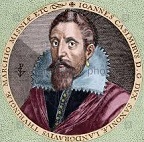

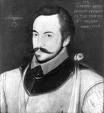

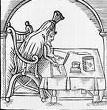




1583 In Jan. the Duke of Anjou turns on the Dutch rebels and attacks several of their cities, sacking Antwerp, but is forced to flee to France in disgrace; William of Orange accepts the sovereignty of the N Netherlands. In Feb. the Cologne (Seneschal) (Sewer) War (ends 1588) begins when drunken horndog Gebhard Truchsess von Waldburg (1547-1601), archbishop-elector of Cologne, who was caught living with concubine Agnes and decided to become a Protestant to make an honest woman of her, announcing his conversion last Dec., but refusing to resign, finally goes through with the marriage, and is excommunicated and deposed in Apr. by Pope Gregory XIII, who appoints genuine Catholic throwback Ernest of Bavaria (1554-1612), bishop of Liege (brother of Duke William V of Bavaria) as his successor (after which the position becomes a Bavarian thing until 1761); meanwhile Gebhard, who had already built up an army doesn't just hand the bishopric over, and after asking for help from elector Augustus I of Saxony, who doesn't like his Calvinist friends, and Henry of Navarre, who tries in vain to form a coalition to aid him, Calvinist John Casimir, Count Palatinate of Simmern (1543-92) (who sent his portrait to Elizabeth I of England in 1564 hoping to wow her, in vain), the new regent of the Rhine Palatinate (until 1592) comes to his aid in Oct., but is defeated, and Gebhard is driven from Bonn to refuge in Strasbourg, where he later moves to the Netherlands and becomes friends with Robert Dudley, 1st earl of Leicester, but fails to talk Elizabeth I into helping him make a comeback. On May 23 the exiled Duke of Lennox dies in Paris; on June 27 James VI escapes from imprisonment at the House of Ruthven after 10 mo. (Aug. 1582), and James Stewart, earl of Arran begins regent (until 1585). On June 11 Sir Humphrey Gilbert (1539-83) (half-brother of Sir Walter Raleigh), looking for a passage to Cathay sails from Plymouth, England to Newfoundland in the 40-ton flagship Golden Hind (Hinde) (originally the Pelican until 1577), arriving on Aug. 3 and becoming the founder of the first English colony in North Am. at St. John; after the colonists mutiny, he dies on the return voyage on Sept. 9 after deciding to sail in the 10-ton Squirrel, and it goes down with the entire crew in a storm off the Azores. On July 6 Edmund Grindal (b. 1519) dies, and John Whitgift (1530-1604), bishop of Worcester becomes archbishop of Canterbury, going on to persecute Puritans without any mental qualms and become known as a "narrow, mean, tyrannical priest, who gained power by servility and adulation" (Thomas Babington Macaulay), sometimes being attended by a retinue of 800 horsemen. In July after Elizabeth's secy. Francis Walsingham arrests several of the conspirators in an alleged plot by Philip II, the Spanish ambassador, and the Guises to invade England and overthrow her, Sir Francis Throckmorton (b. 1554) is arrested and executed. In Oct. after announcing that he's going to shoot Elizabeth I and setting out for London, secret Roman Catholic John Somerville of Warwickshire (b. 1560) of Castle Bromwich, Park Hall, Warwickshire is arrested, and after being racked and confessing hangs himself in his cell in the Tower of London after implicating his priest named Hall and his father-in-law Edward Arden (b. 1542), son of William Arden, 2nd cousin of Shakespeare's mother Mary Arden, who is hanged, drawn, and quartered on Dec. 20 in the Smithfield for plotting against Elizabeth I and being a secret Roman Catholic. The Desmond War (begun 1579) ends with the Irish put back in their place, until next time. Philip Sidney, who had retired to live with his sister Lady Pembroke after falling under the queen's displeasure is knighted and restored to her favor. A Jesuit residence is built in Tartu by Polish king Stefan Bathory, who gives Tartu a red-white flag. The Siamese invade Cambodia with 100K men, killing the king and departing with 50K POWs. Despite the attempts of Valide sultan (co-regent) Nur Banu (b. 1525) (widow of Selim the Sot) to lure her son Sultan Murad III (d. 1595) away from his favorite wife, Venetian-descent Sophia (Sofia) (Safieh) ("the light or pure one") Baffo (1550-1605) (a distant relative?) by delivering him a stream of curvaceous concubines on Fridays, she dies (poisoned by an agent from Genoa?), and Sophia Baffo becomes the new Valide Safiye Sultan (until 1594). After entreaties from his envoy Bogdan Yakovlevich Belsky (-1611), Elizabeth I refuses aging Tsar Ivan IV the Terrible permission to marry Lady Mary Hastings in order to cement an alliance, and she becomes known as the Tsarina of Muscovy. English expeditions to Mesopotamia, India and the Persian Gulf are led by merchants Ralph Fitch and John Eldred (end 1591). Mughal emperor Akbar the Great changes the name of the N Indian city of Prayag in Uttar Pradesh at the confluence of the Ganges and Yamuna Rivers (where Brahma allegedly offered his first sacrifice after creating the world) to Allahabad (City of Allah) (modern-day pop. 1.1M/1.2M). San Luis Potosi (Potosí) in C Mexico (modern-day pop. 2.7M) is founded by Franciscan monks as a mission. The Accademia della Crusca scholarly society is founded in Florence, Italy by Antonio Francesco Grazzini (Il Lasca) (1503-84), with the mission of maintaining the purity of the Italian language, going on to compile a definitive dictionary, and administrate the Test di conoscenza della lingua italiana (Test of knowledge of the Italian language). The first known life insurance England is issued on the life of William Gibbons. The Queen's Co. of Players is formed in London by Sir Edmund Tilney (Tylney) (1536-1610) after the Puritan-run Corp. of London closes the theaters on the Surrey shore under the claim that they spread the plague each summer. English dramatist Robert Greene (1558-92) returns from a 5-year tour of Europe and settles in London, spending the rest of his short life in debauchery while writing some great drama, verse, and prose. Architecture: Gen. Toyotomi Hideyoshi lays the foundation of Osaka Castle in Osaka, the Venice of Japan at the head of the Gulf of Osaka at the mouth of the Yodo River, whose source is Lake Biwa (finished in 1587). Nonfiction: Andrea Cesalpino (1519-1603), De Plantis (16 vols.); dedicated to Francesco I de' Medici; most important work on botany until Carl Linnaeus, making the first scientific classification of flowering plants, using the organs of fructification as the foundation. Carolus Clusius (1526-1609), Rariorum Stirpum per Pannonias Observatorium Historiae; first book on Austrian-Hungarian alpine flora, which he studied under the auspices of HRE Maximilian II, becoming the first botanist to climb Mt. Otscher and Mt. Schneeberg. Henry Howard, 1st Earl of Northampton (1540-1614), A Defensative against the Poyson of Supposed Prophecies; an attack on judicial astrology, declared to contain heresy and treason, getting him imprisoned for a time. Francesco Sansovino, Del Governo et Ammistrazione di Diversi Regni et Republiche. Joseph Justus Scaliger (1540-1609), Opus Novum de Emendatione Temporum (Paris); lays out a system of chronology on scientific principles, expanding the realm of classical history from ancient Greece and Rome to Egypt, Babylonia, Israel, and Persia, establishing him as the "Father of Chronological Science" and the leading Renaissance scholar of the classics (greatest since Aristotle or Marcus Terentius Varro?); Bible-thumpers later latch onto his work to prove the divine origin of the Bible and predict the date of Armageddon; really a bunch of moose hockey based on the Qabala and repeating shifts of dates based on the numbers 333 and 360? Sir Thomas Smith (1513-77), De Republica Anglorum: The Manner of Government or Policie of the Realme of England (posth.); says that England is a commonwealth, and all commonwealths are of mixed character. Philip Stubbes, Anatomie of Abuses; a lampoon of Elizabethan dress and manners. Art: Giovanni da Bologna (1524-1608), The Rape of the Sabines (sculpture). Music: Claudio Monteverdi (1567-1643), Madrigali Spirituali (First Book of Madrigals) (four parts); his first work, at age 16. Plays: Robert Ganier (1545-90), Les Juives (The Jews) (tragicomedy). Poetry: Baptista Honwaerd, Pegasides Pleyn Amorosity (didactic). Novels: Robert Greene (1558-92), Mamillia; written in imitation of John Lyly's "Euphues". Births: Dutch theologian Simon Episcopius (Bisschop) (d. 1643) on Jan. 8 in Amsterdam; educated at the U. of Leiden. Dutch statesman-jurist Hugo Grotius (Huig de Groot) (d. 1645) on Apr. 10; he, Samuel von Pufendorf, and Emerich de Vattel codify the protocols of ambassadors, such as whether they should meet at the foot or top of stairs? Swedish chancellor (1612-54) Count Axel Gustafsson Oxenstierna (Oxenstjerna) (Oxenstiern) (d. 1654) on June 16 in Fano (Fanö), Uppland; created count in 1645. German Thirty Years' War soldier Dodo Knyphausen (d. 1636) on July 2 in East Frisia. French Jesuit theologian Dionysius Petavius (Denis Petau) (d. 1652) on Aug. 21 in Orleans; educated at the U. of Paris. German Lutheran elector of Saxony (1591-1611) Christian II (d. 1611) on Sept. 23; eldest son of Christian I (1630-91) and Sophie of Brandenburg; brother of Johann Georg I (1585-1656). Italian composer Girolamo Frescobaldi (d. 1643) in Sept. in Ferrara; student of Luzzasco Luzzaschi and Carlo Gesualdo. English organist-composer Orlando Gibbons (d. 1625) on Dec. 25 in Cambridge. Italian painter Antonio Marziale Carracci (d. 1618) in Venice; son of Agostino Carracci (1557-1602). Austrian gen. (military leader in the Thirty Years' War) Albrecht Eusebius Wenzel von Wallenstein, Duke of Friedland and Mecklenburg, and Prince of Sagan (d. 1634) near Koniggratz. Indonesian Aceh Darussalam sultan (1607-36) (Sunni Muslim) Iskanadar Muda 9d. 1636). English "A New Way to Pay Old Debts" dramatist Philip Massinger (d. 1640) in Salisbury; educated at St. Alban Hall, Oxford U. German nobleman Georg of Calenberg, Duke of Brunswick-Luneburg-Calenberg (d. 1641). French chemist-physician Jean Rey (d. 1645) (b. 1582?) in Le Bugue, Perigord; educated at the U. of Montpellier. Scottish theologian (#2 after John Knox) Alexander Henderson (d. 1646) in Criech, Fife; educated at the U. of St. Andrews. Deaths: Italian architect-artist Pirro Ligorio (b. 1512) on Oct. 30 in Ferrara. Flemish composer Ihan Gero (b. 1518). English archbishop of Canterbury (1576-83) Edmund Grindal (b. 1519) on July 6. Swiss theologian Thomas Erastus (b. 1524) on Dec. 31 in Basel. Venetian-born Ottoman Valide sultana (1574-83) Nur-Banu (b. 1525). Spanish conquistador Juan de Garay (b. 1528) on Mar. 20 near Rio de la Plata; ambushed by Querandies natives on the Carcarana River en route from Buenos Aires to Santa Fe. English soldier-navigator Sir Humphrey Gilbert (b. 1539) (drowned in the Azores). English royal favorite Esme Stewart, 1st duke of Lennox (b. 1542) on May 26.



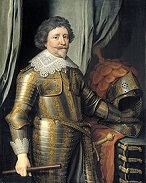



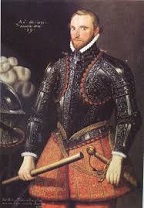




1584 The Roman Catholic states of Germany and Switzerland adopt the Gregorian Calendar. On Mar. 25 Sir Walter Raleigh (1552-1618) is knighted and granted a patent by Elizabeth I to explore and colonize North Am., threatening revocation if he doesn't establish a colony, causing him to explore the E coast, founding the first English settlement on Roanoke Island off the coast of N.C. next year by sending a 7-ship fleet under adm. his cousin Sir Richard Grenville (1542-91) and gen. Sir Ralph Lane (1532-1603), where Bohemian mining expert Joachim Gans (Ganse) researches the copper smelting techniques of the native tribes, which take only four days vs. 16 weeks for Euros; Jews are still not allowed in England under thhe 1290 expulsion order of Edward I; Raleigh sends Philip Amadas and Arthur Barlowe to explore the coast of modern-day N.C., and they return with news of king Wingina, ruler of the kingdom of Wingandacoa, causing England to annex the vast undefined area of Virginia (Va.) (N.C. to Fla.), named for Virgin Queen Elizabeth I, which is good, since on his next voyage Raleigh finds out that wingandacoa actually means "What good clothes you're wearing" in Algonquian - he ought to know better? Out steps Johnny B. Goode? On Mar. 28 (Mar. 18 Old Style) after becoming overwhelmed with guilt and remorse and entering a religious order of hermits under the name of Jonah, tsar (since Dec. 3, 1533) Ivan IV the Terrible (b. 1530) dies after conquering the khanates of Kazan, Astrakhan, and Sibir (Siberia) and expanding his state to 1.56M sq. mi. (4.05M sq. km), his kingdom on the verge of anarchy, and his feebleminded son Fyodor (Theodore) I (the Bellringer) (1557-98) becomes the last Rurikid tsar of Russia (until Jan. 7, 1598); Boris Godunov (1551-1605), brother of his wife, whom Ivan IV had appointed guardian and regent becomes the #1 big man in Russia and head of state, colonizing Siberia and becoming the first Russian ruler to exile political enemies there; meanwhile Ivan IV's other son tsarevich Dmitri Ivanovich of Uglich (Moscow) (1582-91) waits in the wings, but is declared illegitimate and banished from Moscow because he is the son of Ivan's 8th wife, and the Orthodox Church only recognizes the right to have three - mama don't take my cold old throne away? On Apr. 17 the earls of Mar and Angus storm Stirling in an attempt to seize William Ruthven, 4th Lord Ruthven, 1st Earl of Gowrie (b. 1541), and on Apr. 28 Gowrie is charged with treason, and executed in May. On June 19 Henry II's and Catherine de' Medici's son Duke Francois of Alencon (b. 1555) dies of a fever in France at Chateau-Thierry, becoming the last direct Valois heir to the French throne; Henry III having no sons, the French succession passes to Huguenot Henry of Navarre (1553-1610) (future Henry IV), freaking out the Guise family and their Catholic Holy League and causing them to step up their popular movement and secure control of most French cities. On June 19/20 after being smuggled into Dublin in fall 1583 and getting arrested in Sept. while staying with Lord treasurer of Ireland Thomas Butler, 10th Earl of Ormond without his consent, followed by torture and a kangaroo trial after refusing to convert to Protestantism, Roman Catholic archbishop of Cashel, Ireland (since 1583) Dermot O'Hurley (b. 1530) is hanged in Hoggen Green, Dublin, joining the Irish Catholic Martyrs; on Sept. 27, 1992 he is beatified by Pope John Paul II.
If you can't win by the front door, try the back door? On July 10 after Philip II puts a price on his head in 1581, 51-y.-o. "Soldier of the Reformation" Lutheran prince of Orange (since July 15, 1544) William I the Silent (b. 1533) is assassinated in Delft by insane Balthazar Gerard (Gérard) (1557-84); next Nov. 1 after being elected as statholder, his son Maurice of Nassau, Prince of Orange (1567-1625) carries on for the next 40 years (until Apr. 23, 1625), followed by his other son Frederick Henry (Frederik Hendrik), Prince of Orange (1584-1647) for 22 years (until Mar. 14, 1647), followed by Frederick Henry's son William II, Prince of Orange (1626-50) (until Nov. 6, 1650), who finally gains the Dutch a guarantee of freedom. In July the Spanish army under Spanish Netherlands gov. (1578-92) Alessandro Farnese, Duke of Parma and Piacenza (1545-92) begins the Siege of Antwerp (ends Aug. 1585), defended by Philip (Philips) van Marnix, Lord of St. Aldegonde (1540-98); Farnese cuts off sea access with a boat bridge across the Scheldt from Calloo to Oordam; the siege becomes the first time a bomb is used; too bad, the porous lines of the siege allow smugglers to bring in grain, until the city decides to set a maximum price on it, making them not want to bother, causing starvation. In the autumn the Protestant League of Gentlemen is formed in England to protect Queen Elizabeth and kill Mary, Queen of Scots in the event of a Roman Catholic invasion; it is legalized by parliament in 1586. In Oct. the pamphlet Leicester's Commonwealth: The Copy of a Letter Written by a Master of Arts of Cambridge is pub., attacking Queen Elizabeth's favorite Robert Dudley, 1st earl of Leicester as a traitor like his father the Lord Protector Northumberland, accusing him of Puritan sympathies, calling him an amoral opportunist of "almost satanic malevolence", detailing stories of his scandalous deds and dangerous plots; she has it suppressed as Roman Catholic propaganda, which doesn't stop it from hurting his rep for cents. On Aug. 9 Philip II of Spain appoints the most Catholic Alvaro de Bazan (Álvaro de Bazán), 1st Marquis of Santa Cruz (1526-88) as Capt.-Gen. of the Ocean Sea to kick pesky Protestant British naval butt; known for never having lost a battle and for his personal galley La Loba (the She-Wolf) (named after its golden figurhead), he is given orders to plan an invasion of England after assembling a Spanish Armada, but the ineptness of the king and his administrators keeps him from getting very far before his premature death in Lisbon on Feb. 9, 1588. Philip Howard, 13th earl of Arundel is suspected of plotting against Queen Elizabeth's govt. and ordered to remain under house arrest, but attempts to flee England (for Douay?), is caught and sentenced to life in prison; being a Howard, he is released after a time, then rearrested for high treason and condemned to death, croaking in prison in 1595; meanwhile he manages to father a son, Thomas Howard, 2nd Earl of Arundel (1585-1646) - reflections of the way life used to be? In late Dec. Welsh courtier and MP William Parry (Parrie) (-1585), a Roman Catholic double agent hides in Elizabeth's gardens at Richmond, intending to assassinate her, but chickens-out and is exposed six weeks later, then expelled from Parliament on Feb. 11, tried on Feb. 18, and hanged on Mar. 2 in front of Westminster Palace - thanks for being the best agent in the whole wide world? A royal audiencia is established in the Philippines to check abuses of power by the colonial govs., who are virtually independent of Manila. Earthquakes, plague, and crowds in Vienna cause moody, nervous, reclusive Rudolf II to move the residence of the HRE permanently to Prague, where in the comparative tranquility he takes up the collection of rare and beautiful things, as well as magic and astronomy, and assembles a cast incl. Tycho Brahe and Johannes Kepler, giving Prague its golden age. Gen. Toyotomi Hideyoshi takes complete control of Kyoto and gains the title kanpaku, representing civil and military control of all Japan. The Dutch found a trading post in Archangel, Russia. The city of Thingvalla on the island of Tingvalla in Lake Vaner, Sweden near the estuary of the Klar R. 200 mi. W of Stockholm is renamed to Karlstad. The Accademia Lucchese dei Scienze, Lettere ed Arti is founded in Lucca, Italy. Emmanuel College at Cambridge U. is founded by Puritan Sir Walter Mildmay (1523-89), English chancellor of the exchequer to produce learned Protestant religious ministers to compete with the output of the Roman Catholic Dominican schools. Uppingham School is founded in Uppingham, Rutland, England as a hospital by Robert Johnson (1540-1625), archdeacon of Leicester. Architecture: The Cordouan Lighthouse at the mouth of the Gironde River in France is begun (finished 1611), becoming the oldest wave-swept lighthouse to survive to modern times. Nonfiction: Giordano Bruno (1584-1600), La Cena de le Ceneri (The Ash Wednesday Supper) (London); De la Causa, Principio et Uno (On Cause, Principle and Unity) (London); De l'Infinito Universo et Mondi (On the Infinite Universe and Worlds) (London); Lo Spaccio della Bestia Trionfante (The Expulsion of the Triumphant Beast) (London). Richard Hakluyt (1552-1616), A Discourse of Western Planting; written by an English Roman Catholic priest, it provides Protestants with an impetus to colonize America to beat the Catholics to it. Jon Jonsson, Gudbrands Biblia; the first complete printed Bible in Icelandic. John Knox (1505-72), Hystory of the Reformation of Religioun within the Realme of Scotland (posth.). Gian Paolo Lomazzo (1538-1600), Trattato dell'Arte della Pittura, Scoltura et Architettura; art crticism based on the concept of decorum. Nicholas Sanders (1530-81), De Origine ad Progressu Schismatis Anglicani (posth.). Reginald Scot (1538-99), The Discoverie of Witchcraft, wherein the Lewde dealing of Witches and Witchmongers is notablie detected, in sixteen books ... whereunto is added a Treatise upon the Nature and Substance of Spirits and Devils (16 vols.); argues against belief in witches, showing how their feats of magic are accomplished, becoming the first textbook on magic (conjuring). Plays: John Lyly (1553-1606), Alexander and Campaspe (Jan. 1) (Blackfiars Theatre, London); Sapho and Phao (Mar. 3) (Blackfriars Theatre, London).Poetry: Honore d'Urfe (1568-1625), La Sireine; pastoral poem. Guillaume de Salluste, Sieur Du Bartas (1544-90), L'Uranie; Judit. Novels: John Lyly (1553-1606), Euphues; The Myrrour of Modestie. Barnabe Rich, Second Tome of the Travels and Adventures of Don Simonides. Births: Dutch prince of Orange (1625-47) Frederick Henry (Frederik Hendrik) (d. 1647) on Jan. 29 in Delft; youngest child of William I the Silent (1533-84) and Louise de Cologny; half-brother of Prince Maurice of Orange (1567-1625); born 6 mo. before his father's assassination on July 10. English Civil War Parliamentary gen. Ferdinando, 2nd Lord Fairfax of Cameron (d. 1648) on Mar. 29 in Yorkshire; father of Thomas, 3rd lord Fairfax of Cameron (1612-71); MP from 1614-29 and 1640 (Long Parliament). German composer Melchior Teschner (d. 1635) on Apr. 29 in Silesia. German poet Georg Rudolf Weckherlin (d. 1653) on Sept. 15 in Stuttgart; secy. for foreign tongues in England (1644-9). English courtier (favorite of James I) Philip Herbert, 4th Earl of Pembroke, 1st Earl of Montgomery (d. 1650) on Oct. 16 in Wilton House; son of Henry Herbert, 2nd earl of Pembroke (1534-1601) and Mary Sidney Herbert (1561-1621); brother of William Herbert, 3rd earl of Pembroke (1580-1630); educated at New College, Oxford U.; husband of Susan de Vere (daughter of the 17th earl of Oxford); Shakespeare's First Folio is dedicated to the "Incomparable Pair of brethren". English "The Knight of the Burning Pestle", "The Maid's Tragedy" dramatist Francis Beaumont (d. 1616) in Grace-Dieu, Leicestershire; partner of John Fletcher (1579-1625). Italian freethinking philosopher Lucilio Vanini (d. 1619) in Taurisano (near Lecce). English navigator-explorer William Baffin (d. 1622) in London. English Puritan MP John Pym (d. 1643) in Brymore, Somerset; educated at Pembroke College, Oxford U. Spanish dramatist Tirso de Molina (Gabriel Tellez) (d. 1648). Flemish Baroque painter Cornelis de Vos (d. 1651) in Hulst (near Antwerp). English Puritan soldier Capt. Myles (Miles) "Capt. Shrimp" Standish (d. 1656) in Lancashire (Isle of Man?); born of "the house of Standish of Standish"; his ancestral lands are "surreptitiously detained from him", forcing him to become a mercenary in Holland. French physician (Henry IV, Louis XIII, Louis XIV) Charles de Lorme (De L'Orme) (d. 1678) in Moulins; son of Marie de' Medici's doctor Jean Delorme; educated at the U. of Montpellier. English pickpocket ("the Roaring Girl") Mary Frith (Moll Cutpurse) (d. 1659) in the Barbican, London. Deaths: Indian saint Surdas (b. 1478). Italian scholar Antonio Francesco Grazzini (Il Lasca) (b. 1503) on Feb. 18 in Florence. French architect Jacques Androuet du Cerceau (b. 1515). Russian tsar (1543-84) Ivan IV the Terrible (b. 1530) on Mar. 28 (Mar. 18 Old Style) in Moscow. Polish poet Jan Kochanowsky (b. 1530) on Aug. 22 in Lublin. English interrogator-poet Thomas Norton (b. 1532) on Mar. 10. Dutch prince of Orange (1544-84) William I the Silent (b. 1533) on July 10 in Delft (assassinated). Italian composer Pietro Vinci (b. 1535). Italian prelate (St.) Carlo Borromeo (b. 1538). Flemish painter Mathys Bril (b. 1550). French duke Francois of Alencon (b. 1555) on June 19 in Chateau-Thierry, Paris (malaria); last of the Valois line.







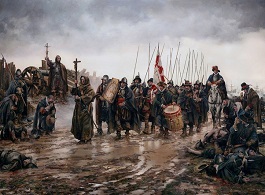

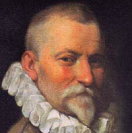
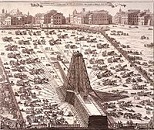
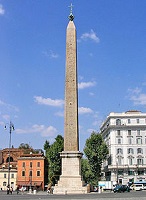
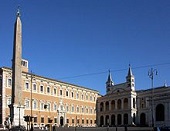
1585 On Apr. 10 Calendar Pinup Pope (since 1572) Gregory XIII (b. 1502) dies, and on Apr. 24 former swineherd Felice Peretti is elected Pope (#227) Sixtus (Sextus) V (1521-90), becoming known as "the Iron Pope"; Nostradamus had allegedly long before (c. 1540) passed the young monk on the street, knelt down, and addressed him as "Your Holiness"; on Sept. 9 he excommunicates Huguenot Henry of Navarre (Bourbon) (future Henri IV), who raises taxes to pay for a huge construction program. In May Philip II orders the seizure of all English ships in Spanish ports, to be added to his Lisbon fleet; meanwhile Elizabeth I shocks Roman Catholic Europe by corresponding with Sultan Murad III in hopes of a miltiary alliance against Spain, writing that Islam and Protestantism have "much more in common than either did with Roman Catholicism, as both rejected the worship of idols" - which doesn't mean that Islam doesn't want to exterminate both? On July 4 a 7-ship fleet under Sir Richard Grenville (1542-91) brings 100 English settlers under Ralph Lane (1532-1603) to Roanoke Island in Virginia (in modern-day N.C.) to set up a base for privateering on Spanish treasure fleets, and they settle on the N side (until 1586); too bad, they kidnap Indians and hold them hostage in exchange for info. on food, pissing them off; the settlers incl. Celts, Germans, Jews et al.; in 1593 Lane is knighted by Elizabeth I. In July the Munster Plantation is begun by the stankin' English as punishment for the Desmond Rebellions, with the depopulated estates of the Geraldine Desmond dynasty confiscated and given to colonists from England and Wales as a bulwark against future rebellions, starting with sending a commission led by Ireland surveyor-gen. (since 1559) Sir Valentine Browne (1510-89) to allocate confiscated lands to English Undertakers, wealthy colonists who undertake to import tenants, develop new towns, and provide for common defense; lands are confiscated in the modern-day counties of Cork, Kerry, and Limerick; by 1589 700 English tenant families plant 500K acres; too bad, English soldiers are withdrawn in the 1590s, and in 1598 the Nine Years War causes most settlers to flee to walled towns or back to England, and the plantation isn't reconstituted until after the rebellion ends in 1603 by Munster gov. George Carew. On Aug. 6 commoner Gen. Toyotomi Hideyoshi (1537-98) is appointed regent (tampaku), and attempts to establish a dictatorship in Japan; in Nov. he holds a Grand Kitano Tea Ceremony to wow his subjects, followed by the Great Sword Hunt, wherein he confiscates his subjects' weapons. On Aug. 15 Antwerp capitulates due to famine, after which it starts to fall behind Rotterdam and Amsterdam as an internat. port; Philip van Marnix is dissed by the English and Dutch for surrending, causing him to retire from public service and begin a translation of the Bible; the Spanish go on to reconquer practically all of S Netherlands; meanwhile after both Henry II of France and Elizabeth I of England decline sovereignty of the Netherlands, in Aug. Elizabeth makes a treaty taking them under her protection, and on Sept. 17 sends English troops to their aid, led by the earl of Leicester, with Sir Thomas Fludd (1530-1607) (Robert Fludd's father) as treasurer; in Sept. she makes Sir Francis Drake an admiral with a fleet of 22 ships, and sends him to capture Spanish bases Santo Domingo, Havana, and Cartagena in the Caribbean; he does so after first capturing Vigo on the coast of Spain; Martin Frobisher accompanies him as vice-adm. on the Primrose. On Nov. 2 the Earl of Arran's control over the king is brought to an end, and 19-y.-o. James VI of Scotland, after four regents begins his rule at age 21; Scotland has suffered from a long succession of child kings and has been ruled by regents for 100 of the years since 1406? - whadya expect for men who wear skirts? On Dec. 8 the Battle (Miracle) of Empel in the Netherlands sees 3K-4K Spanish soldiers under Juan de Aguila surrounded by 100 Dutch heretic ships under Adm. Philip of Hohenlohe-Neuenstein, causing the Spanish to be resigned to die rather than surrender until a soldier digs up a painting of the Virgin Mary and an unexpected night freeze allows them to burn the ships and kill hundreds of heretics, scoring a big V that they give to Mary, who is proclaimed the patroness of the Spanish Tercios of Flanders and Italy; after the battle, the Dutch adm. utters the soundbyte: "It seems that God is Spanish to work such a miracle for them." The original That Girl? On Dec. 24 (Xmas Eve) Mary Stuart is moved from Tutbury to Essex's moated castle at Chartley 12 mi. away. Pasquale Cicogna (-1595) becomes doge #88 of Venice (until 1595), which is in such a bad way that he throws silver instead of gold coins at his ascension, causing them to be called cicognini; he goes on to convert the Rialto Bridge over the Grand Canal from wood to stone in 1588-91. Elizabeth I quashes a Puritan Bill attempting to ban all entertainment and sports on Sunday. Pope Sixtus V appoints his protege, Swiss architect Domenico Fontana (1543-1607) as papal architect (until 1592), and he begins completing Michelangelo's 1547 plans for the dome of St. Peter's in Rome along with Giacomo della Porta (finished 1590); next year he engineers the moving of a 327-ton Egyptian obelisk from the Roman Circus of the Vatican to the front of St. Peter's Square, which requires 900 men and 75 horses, going on to erect three more in the Piazza del Popolo (where public executions are held until 1826), incl. the Piazza di Santa Maria Maggiore, and Piazza di San Giovanni in Laterano (Aug. 9, 1588); he also designs the Palace of Monte Cavallo, the Vatican Apostolic Library, the Lateran Palace (Apostolic Palace of the Lateran) (1586-9), the Acqua Paolo Fountain, the Acqua Paolo Fountain on the Janiculum Hill (1612), and the Acqua Felice Aqueduct (along with his brother Giovanni Fontana) in the Quirinal (1585-8). The Kingdom of Luba in modern-day Katanga, S Dem. Repub. of Congo (DRC) is founded by King Kongolo Maniema, whose nephew-successor Kalala Ilunga expands the empire to the upper left bank of the Lualaba River, with a pop. of 1M, and an economy based on fishing, farming, and metal-working, with the kings considered sacred like in ancient Egypt; in 1889 after white Euro (mainly Belgian) colonists raid the empire for slaves, the kingdom is split in two by a succession dispute, and is later absorbed into Belgium's Congo Free State. A Jesuit U. is founded in Graz, Austria, future home of Ahnuld (Arnold Schwarzenegger) - conspiracy theory here? The Frankfurt Stock Exchange in Germany is founded to set up fixed currency exchange rates, moving in 1874 to a new bldg. at Borsenplatz where a statue of a bull and bear stand in front (stealing the idea from the Yanks?), and going on to become the 3rd biggest world stock exchange. Old Bailey is first mentioned as the sessions house of the lord mayor and sheriffs of the city of London and of Middlesex, located next to the Newgate Gaol, funded by wealthy former mayor of London Sir Richard "Dick" Whittington (1354-1423); it burns down during the 1666 Great Fire of London, and is rebuilt in 1674, with an open court to prevent the spread of disease until 1734, when it was enclosed, leading to typhus outbreaks, with 60 dying in 1750 incl. the lord mayor and two judges; it is rebuilt again in 1774, and a 2nd courtroom added in 1824; in 1674-1834 100K+ criminal trials are held. English explorer John Davis (1543-1605) searches for a Northwest Passage in two ships named Sunshine and Moonshine, discovering the Davis Strait between Baffin Island (Canada) and Greenland; he gives up in 1587. William Shakespeare (1564-1616) leaves Stratford-upon-Avon for London, joining a band of actors and promising to send money back to his family (an unhappy marriage, or too dangerous for them to come along?); he signs up with one of the two chief playing companies, that of James Burbage (Burbadge) (1531-97) (father of Richard Burbage), beginning his Johannes Factotum (Jack of All Trades) Age (1587-92) - signed, sealed, delivered, I'm yours? English actor Edward Alleyn (1566-1626) becomes head of the Lord Chamberlain's Men and the Lord Admiral's Company. Florentine painter Bartolommeo Carducci (1560-1638) accompanies his teacher Federico (Federigo) Zuccari (1542-1609) to Madrid to decorate the new Escorial Palace, where he is known as Bartolome Carducho, going on to paint the ceiling of the Escorial Library; Zuccari returns to Rome at the end of 1588 after Philip II finds his paintings disagreeable. Architecture: The Teatro Olimpico (Olympic Theater) in Vicenza, Italy opens, designed by Andrea Palladio (1508-80). Inventions: Bartholomew Newsam (1530-87) of the Strand, London constructs the first English traveling and standing clocks. Flemish mathematician-engineer Simon Stevin (Stevinus) (1548-1620) pub. the booklet "Die Thiende" (The Art of Tenths), expounding the use of decimal fractions, causing their daily use; he goes on to predict the universal introduction of decimal coinage, weights, and measures; in 1600 he invents the first wind-driven land vehicle. Art: El Greco (1541-1614), The Virgin of the Immaculate Conception and St. John. Paolo Veronese (1528-88), Apotheosis of Venice (Sala de Gran Consiglio, Venice). Nonfiction: Giordano Bruno (1548-1600), De gl'Heroici Furori (On Heroic Frenzies) (London). Lucas Janszoon Waghearen, Spiegel der Zeevaart. Plays: Miguel Cervantes (1547-1616), Galatea (pastoral romance). Battista Guarini (1538-1612), Il Pastor Fido (pastoral) (Turin). Births: English Catholics founder Mary Ward (d. 1645) on Jan. 23. Danish physician-scientist (child prodigy) Caspar Bartholin the Elder (d. 1629) on Feb. 12 in Malmo, Sweden; head of a family of scientists, 12 of whom become profs. at the U. of Copenhagen; father of Thomas Bartholin (1616-80) and Erasmus Bartholin (1625-98); gives up science for theology after an illness. German Protestant Wettin elector of Saxony (1611-56) Johann Georg (John George) I (d. 1656) on Mar. 5 in Dresden; 2nd son of Christian I (1560-91) and Sophie of Brandenburg; brother of Christian II (1583-1611); father of Johann Georg II (1613-80). English art collector Thomas Howard, 2nd (21st) Earl of Arundel, 2nd (4th) Earl of Surrey and 1st Earl of Norfolk (d. 1646) on July 7; son of Philip Howard, 13th Earl of Arundel (1557-95) and Anne Dacre (daughter of Thomas Dacre, 4th baron Dacre); grandfather of Thomas Howard, 5th duke of Norfolk. French statesman cardinal (1622-) ("the Red Eminence") Armand Jean du Plessis, Duke de Richelieu (d. 1642) on Sept. 9 in Paris; founder of the Academie Francaise. German composer-organist Heinrich Schutz (Schütz) (d. 1672) on Oct. 8 in Kostritz; influences J.S. Bach and Dietrich Buxtehude. Dutch Roman Catholic bishop-theologian (founder of predestinationist Jansenism) Cornelius Jansen (Corneille Janssens) (d. 1638) on Oct. 28 in Acquoy, Gelderland. Am. "Milk for Babes" Puritan divine ("the Patriarch of New England") John Cotton (d. 1652) on Dec. 4 in Derby, England; grandfather of Cotton Mather (1663-1728). Scottish author-poet William Drummond of Hawthornden (d. 1649) on Dec. 13 in Hawthornden Castle, Midlothian. English explorer (Maine) George Weymouth (d. 1612) in Cockington, Devon. Am. religious leader ("the Apostle of Virginia") Alexander Whitaker (d. 1616) in Cambridge, England; son of William Whitaker (1548-95); educated at Trinity College, Cambridge U. Dutch poet-playwright (co-founder of the Amsterdam Theater) Gerbrand Adriaensz Bredero (d. 1618). Virginia tobacco pioneer John Rolfe (d. 1622) in May in Heacham, Norfolk. Am. Pilgrim-friendly Patuxet Indian Squanto (Tisquantum) (d. 1622) in Mass. English Jacobean dramatist-actor William Rowley (d. 1626); collaborator of Thomas Middleton (1580-1627); known for playing fat clowns. Dutch skeptical Jewish philosopher Uriel Acosta (Gabriel da Costa) (d. 1640) in Porto; from a family of conversos (Jews converted to Roman Catholicism); father is a Catholic priest; whole family returns to Judaism in 1617 and flees to Amsterdam; too bad, he becomes a skeptic, and is savagely persecuted by the rabbis. Dutch merchant Pieter van den Broecke (d. 1640) on Feb. 25 in Antwerp. French architect Jean Androuet III du Cerceau (d. 1650); son of Jean Baptiste Androuet du Cerceau (1544-90); famous for his hotels particuliers in Paris. French Baroque architect Jacques Lemercier (d. 1654) in Pontoise. Portuguese Jesuit priest-missionary (in China) Alvaro (de) Semedo (d. 1658 (b. 1586?) in Nisa. Dutch mariner Jacob Le Maire (d. 1616) in Antwerp (Amsterdam?). Am. Puritan tailor Isaac Allerton (d. 1659) in London, England; ancestor of U.S. presidents Zachary Taylor and Franklin D. Roosevelt. Deaths: English organist-composer Thomas Tallis (b. 1505). Flemish botanist Rembert Dodoens (b. 1517) on Mar. 10. French court poet Pierre de Ronsard (b. 1524). Scottish poet "The Admirable" James Crichton (b. 1560) in Mantua (killed in swordfight).



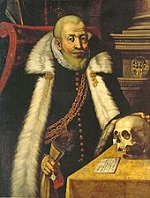




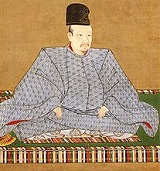
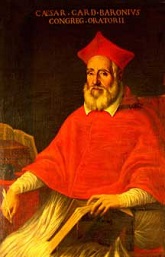
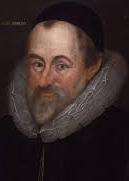

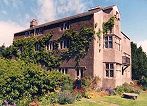
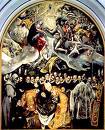
1586 On Jan. 15 the Dutch give Robert Dudley, 1st Earl of Leicester (1533-88) the office of supreme gov. of the Netherlands, which throws Elizabeth I into a jealous tizzy until he steps down? On Feb. 11 Augustus I (b. 1526) dies, and his 6th (eldest surviving) son Christian I (1560-91) becomes elector of sexy Lutheran Saxony (until Sept. 25, 1591), going on to appoint Calvinist councillor Nikolaus Krell (1551-1601), who introduces the Second Reformation, prohibiting the practice of exorcism in 1591 and promoting reconciliation with the Calvinists, promoting them into govt. and church offices and bringing out a German trans. of the Bible with Calvinist annotations. On Mar. 14-27 the Colloquy of Montbeliard ( Montbéliard) attempts a union of the Lutherans and Calvinists, but they can't agree on the universalism or particularism of grace, and after a debate on Sept. 2, 1587, followed by another on Apr. 15-8, 1588 in which Theodore Beza (1519-1605) participates, particularism wins, but they still never unite. Mary Stuart, Queen of Scots nominates Philip II as her successor to the English throne; in Mar. Philip II writes to Pope Sixtus V asking for and receiving the Church's blessing on his planned Enterprise of England, the invasion of England and overthrow of Elizabeth I; Pope Sixtus V promises financial aid to the Spanish Armada. In the spring Sir Francis Drake introduces tobacco pipe smoking to Sir Walter Raleigh before capturing Cartagena in Colombia (capital of the Spanish Main) and sacking St. Augustine on the E coast of Fla.; on June 26 Drake visits Roanoke Island and learns of its woes of recurring Indian attacks and supply shortages; in July after dropping off 15 of his own men (who are never heard from again), he returns the disheartened colonists to England, who cause a sensation by smoking (drinking?) sotweed (tobacco) from pipes; Sir Walter Raleigh becomes the first ranking Englishman to smoke, helping to make the nasty habit fashionable (along with boy buggering)? - red eyes plus a grunt, it'll all make sense? In May James VI of Scotland makes the squabbling nobles walk hand in hand to a royal banquet - to show he's a peacemaker, not to convert them to the other team? On July 6 after meeting in Tolboothin Berwick upon Tweed for a week, Elizabeth I's ambassador Edward Manners, 3rd Earl of Rutland (1549-87) and James VI's ambassador Francis Stewart, 5th Earl of Bothwell (1562-1612) sign the Treaty of Berwick, a mutual alliance guaranteeing aid from the other if an invasion of their homeland should occur; James VI is granted a £4K annual pension from England, signaling that he is considered an heir to the English throne; a plan to make the people of Scotland English citizens is scrapped. On July 21 Thomas Cavendish (1560-92) leaves Plymouth, England on a voyage of circumnavigation with three ships and 123 men, becoming the first to emulate Sir Francis Drake, raiding Spanish towns and ships in the Pacific and circumnavigating the Earth, reaching the Strait of Magellan next Jan. 6, reaching Guam on Jan. 3, 1588, the coast of Africa on May 14, 1588, and returning to Plymouth on Sept. 9, 1588 (2 years 49 days) (9 mo. faster than Drake) with only one ship and 48 crew, parading up the Thames River through London displaying new blue damask sails before being knighted by Elizabeth I, the captured treasure making him rich. On Aug. 9 the Anthony Babington (b. 1561) Conspiracy to assassinate Elizabeth I, traced-out by the spies of Sir Francis Walsingham causes his arrest while out hunting at Chartley; on Sept. 13 Babington and his associates are put on trial, condemned, and executed on Sept. 20-21; the episode convinces the public that Elizabeth cannot be safe as long as Mary lives, causing Parliament to request her to order Mary's execution. On Sept. 18 Ottavio Farnese (b. 1521) dies, and his son Alessandro Farnese (1545-92) (a talented field cmdr., known for his successful campaign against the Dutch Revolt in 1578-92) becomes duke #3 of Parma and Piacenza (until Dec. 3, 1592), requesting leave to visit his new dukedom, and being refused by Philip II, who needs him in the Netherlands; Farnese then proposes an invasion of England with 30K troops in hopes of sparking a Roman Catholic uprising, but Philip II nixes him, instead beginning the planning for the 1588 Spanish Armada. On Sept. 22 a small English army under the earl of Leicester wins a V against Alessandro Farnese's forces at the Battle of Zutphen near Arnhem; Sir Philip Sidney (b. 1554), who had been forbidden by the queen to accompany Drake on one of his expeditions, causing him to go with Leicester to the Netherlands is wounded in the leg, and dies 26 days later on Oct. 17, becoming renowned for refusing a cup of water in favor of a dying soldier, uttering the soundbyte "Thy need is greater than mine", causing his school chum Sir Fulke Greville, who had been forbidden by Elizabeth I to go with him on the expedition to write his "Life of the Renowned Sir Philip Sidney" (pub. 1625); after this the English begin to lose the war, and Leicester returns to England on leave; too bad that Philip II decides it's time for the Spanish Armada to take the English out before their combo with the Dutch gets too dangerous? On Oct. 14 Mary Stuart's trial for treason begins at Fotheringay, and ends with a guilty verdict, leaving her punishment to Parliament and Queen; Parliament convenes on Oct. 29 and votes unanimously for death, which is pub. on Dec. 4, but the queen delays in signing the warrant until next year. On Oct. 19 Egnatio Danti (b. 1536) dies, and in 1588 geocentric astronomer Giovanni Antonio Magini (1555-1617) is chosen over Galileo Galilei for his chair of math at the U. of Bologna. On Dec. 3 after bringing them to Ireland last year, Sir Walter Raleigh's 2nd in command Sir Thomas Herriot arrives in England with the first potatoes (Solanum tuberosum), just in time to combat a severe corn shortage in England this year; too bad, Bible-thumpers can't find them mentioned, so they don't want to plant them, although Roman Catholics later settle for sprinkling them with holy water and planting them on Good Friday; Sir Walter Raleigh later gets the credit instead of him; actually, Raleigh never visited a country that had potatoes? On Dec. 3 Pope Sixtus V issues a bull fixing the number of cardinals at 70 (50 priests, 6 bishops and 14 deacons); he also issues the bull Detestabilis, forbidding usury. On Dec. 12 Stephen Bathory (b. 1533) dies, and his 16-y.-o. nephew Sigismund (Zsigmund) Bathory (1572-1613) becomes prince of Transylvania (until 1613), attaining the age of majority in 1588 and joining the Christian league of princes against the Turks, scaring the turds out of his nobles, who at the Diet of Turda demand that he take the coronation oath a 2nd time, and when he refuses, they begin a revolt, which he quells by 1595, executing every last one of the bums. On Dec. 17 Japanese emperor (since 1557) Ogimachi (b. 1517) resigns in favor of his grandson (eldest son of his 5th son Prince Masahito) Go-Yozei (1571-1617) (personal name Kazuhito) becomes Japanese emperor #107 (until May 9, 1611), going on to preside over the rise of Toyotomi Hideyoshi and the Edo Shogunate (bakufu). Sir John Maitland, 1st Lord Maitland of Thirlestane (1537-95) becomes lord chancellor of Scotland to James VI (until 1593). Swiss Roman Catholic military leader Ludwig Pfyffer (1524-94), known as "the king of the Swiss" forms the League of the Seven Swiss Roman Catholic Cantons (Golden League) (Borromean League), which pledges to expel Protestant heretics, nearly destroying the Swiss Confederation and dividing the canton of Appenzell along religious lines. The military revolts in Egypt, putting the Ottoman gov. under house arrest before it is suppressed; the first of many revolts (1589, 1598, 1601, 1604, 1609), all of which are also suppressed. Tyumen, Russia on the Tura River 1.6K mi. E of Moscow is founded to support eastward expansion. The city of Kuybyshev (Samara) in Russia on the Volga River (modern-day pop. 1.1M) is founded. Architecture: St. John Lateran in Rome is rebuilt. The Escorial Palace near Madrid (begun 1563) is completed. The Egyptian Obelisk brought to Rome in 40 C.E. by Roman Emperor Caligula, which fell sometime in the distant past is moved 275 ft. from the site of the proposed new St. Peter's Basilica to the center of the proposed St. Peter's Square using 40 winches, each operated by a 4-horse team pulling 3-in.-thick ropes with water poured on them to prevent sparks; the task takes 4 mo.; Pope Sixtus V blesses the pagan monument to the Sun with the soundbyte "I exorcise you to bear the holy Cross and remain devoid of all pagan impurity and all assaults of spiritual iniquity". Swarthmoor Hall in Ulverston, Cumbria, England is built by George Fell (son of Margaret Fell), and in 1652 it becomes the birthplace of the Quaker (Society of Friends) movement. Nonfiction: Caesar Baronius (1538-1607), Annales Ecclecsiastici (12 vols.) (1588-1607); history of the Roman Catholic Church to 1198 C.E., bolstering its claims to authority; produced to counter the anti-Catholic "Magdeburg Centuries"; coins the term "Dark Ages" for the period from 500-1100 C.E. Cardinal Robert Bellarmine (1542-1621), Disputations about the Controversies of the Christian Faith Against the Heretics of this Time (1586-93); gives ammo to Roman Catholics against Protestants. William Camden (1551-1623), Britannia; or a Chorographical Description of Great Britain and Ireland, Together with the Adjacent Islands; written in Latin; bestseller, going through seven eds. by 1607; first English ed. tr. by Philemon Holland pub. in 1610; a chorography of Britain county-by county incl. maps and history, becoming the first to paint a coherent picture of Roman Britain. Dirk Volkertszoon Coornhert (1522-90), Zedekunst, dat is Wellevens Kunst. Rene Goulaine de Laudonniere (1529-74), L'Histoire Notable de la Floride, contenant les trois voyages faits en icelles par des capitaines et pilotes français (autobio.) (posth.). Simon Stevin, De Beghinselen der Weeghconst; introduces the law of equilibrium and the triangle of forces; also states that unequal weights fall a given distance in the same time. William Webbe, Discourse of English Poetrie.; reviews English poetry up to his day, and discusses prosody. Art: El Greco (1541-1614), The Burial of Count Orgaz (1586-8); shows his son in the background. Births: German "Musical Banquet" composer Johann Hermann Schein (d. 1630) on Jan. 20 in Grunhain; importer of Italian Baroque music to Protestant Germany. Dutch East Indies gov.-gen. #5 (1623-7) Pieter de Carpentier (d. 1659) on Feb. 19 in Antwerp. Italian Roman Catholic Jesuit philosopher-mathematician Niccolo (Niccolò) Cabeo (Nicolaus Cabeus) (d. 1650) on Feb. 26 in Ferrara. Italian traveler (Asia) Pietro della Valle (d. 1652) on Apr. 2 in Rome. English "Love's Sacrifice", "'Tis Pity She's a Whore" dramatist-poet John Ford (d. 1640) on Apr. 17 in Ilsington, Devonshire; educated at Exeter College. Am. Puritan leader (founder of Conn.) Thomas Hooker (d. 1647) on July 5 in Marefield (Birstall?), Leicestershire, Endland; educated at Emmanuel College, Cambridge U. German "The Chymical Wedding of Christian Rosenkreutz" theologian (Lutheran pietist) Johann Valentin Andreae (Johannes Valentinus Andrea) (d. 1654) on Aug. 17 in Herrenberg, Wurttemberg. Italian astronomer Niccolo Zucchi (d. 1670) on Dec. 6. English "Christ's Victory and Triumph" poet Giles Fletcher the Younger (d. 1623); son of Giles Fletcher the Elder (1549-1611); brother of Phineas Fletcher (1582-1650); cousin of John Fletcher (1579-1625); educated at Westminster School, and Trinity College, College U. Spanish painter Luis Rodriguez Tristan (Tristán) de Escamilla (d. 1624) in Toledo; asst. of El Greco (1603-7). English soldier John Mason (d. 1635) in King's Lynn, Norfolk; founder of New Hampshire (N.H.). French physician ("the first French journalist") ("the inventor of the personal ad") Theophraste (Théophraste) Renaudot (d. 1653) in Loudun; educated at the U. of Montpellier; runs the first pawn shop in Paris (1637); starts out Protestant, then is converted to Roman Catholicism by Cardinal Richelieu after meeting him in London, returning with him to Paris and rising to royal physician of Louis XIII. Greek theologian (keeper of the Vatican Library in 1661-9) Leo Allatius (d. 1669) in Chios. Deaths: English poet Sir Richard Maitland (b. 1496). Spanish painter Luis de Morales (b. 1510) on May 9 in Badajoz. French cardinal-statesman Antoine Perrent de Granvelle (b. 1517) on Sept. 21 in Madrid; leaves a magnificent art collection by Titian, Leone Leoni, Pieter Brueghel, Hieronymus Bosch et al., which HRE Rudolf II buys at lowball prices. Italian composer Andrea Gabrieli (b. 1520). Italian duke of Parma and Pacienza #2 (1556-86) Ottavio Farnese (b. 1521) on Sept. 18. Dutch gov. of the Netherlands (1559-67) Duchess Margaret of Parma (b. 1522) on Jan. 18 in Ortona. German elector of Saxony (1553-86) Augustus I (b. 1526) on Feb. 11 in Dresden. English politician Sir Henry Sidney (b. 1529) on May 5. Italian madrigal composer Bartolommeo Spontone (b. 1529). Polish-Transylvanian king Stephen Bathory (b. 1533) on Dec. 12. Italian priest-astronomer Egnatio Danti (b. 1536) on Oct. 19 in Alatri. English poet-soldier Sir Philip Sidney (b. 1554) on Oct. 17 in the Netherlands (wound in thigh from the Battle of Zutphen); last words: "Thy necessity is yet greater than mine"; buried in St. Paul's Cathedral on Feb. 16, 1587; leaves The Countess of Pembroke's Arcadia., a sensational novel about the Duke of Basilius, who travels to the Oracle at Delphi.




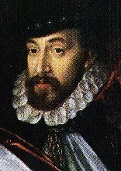





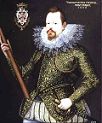

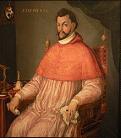





1587 On Feb. 8 after years of cat-and-mouse games trying to position herself to take over and re-Catholicize Elizabeth I's England, 45-y.-o. Mary Stuart (Stewart), Queen of Scots (b. 1542) is executed for treason at Fotheringhay Castle in Northamptonshire after 18 years of house arrest by order of her half-sister Elizabeth I; she dies in grand style, clutching a crucifix and wearing a scarlet petticoat, the Roman Catholic symbol of martyrdom; it takes 3 (15?) strokes of the axe to sever her head, on which the lips keep moving, and the bungling axeman has to finish with a knife; when her head is picked up her red wig falls off, revealing an old woman, partially bald with white hair; her dog runs from out of her cloak, and lays down between her head and body; her clothes are burned and the castle is ordered torn down to discourage pilgrimages by Catholics who consider her a martyr; Elizabeth I, who has never met her makes a show of blaming Mary's execution on errant councillors, admitting that she signed the execution warrant but claiming that she didn't authorize it to be delivered to the executioners, and that they had held a secret meeting to transmit it without authorization, fixing the blame on secy. of state William Davison (1541-1608), whom she dismisses and imprisons as the fall guy, causing his asst. William Brewster (1567-1644) to return to his home town of Scrooby, becoming postmaster and later founding the Puritan Separatists that end up founding Plymouth Colony; James VI of Scotland stifles his urges to avenge his mother because of the large annuity he receives from Elizabeth, and also because he wants to succeed her to the English throne and has to be nice; too bad, Mary had bequeathed her claims to the English throne to Philip II of Spain, providing him with an excuse for an invasion, and the execution of a Roman Catholic martyr by the hated English bastard heretic queen whips up Catholics everywhere; too bad also, the example of a sacred cow royal being executed when their religion stands in the way of the English regime ends up backfiring bigtime with the Stuarts, and forever putting English monarchs on notice? On Apr. 11 3 mo. after presiding over the trial of Mary, Queen of Scots, English lord chancellor (since 1579) Thomas Bromley (b. 1530) dies, and Edward Manners, 3rd Earl of Rutland (1549-87) succeeds him, but dies two days later on Apr. 14 (Good Fri.). In Apr.-June the English under Sir Francis Drake attack the Spanish Armada at Cadiz and Lisbon, delaying it for more than a year; at Cape St. Vincent he destroys their food and water barrels, and captures a huge haul of Spanish treasure in the Azores, incl. 2.9K barrels of sherry, making it popular in Britain. On June 25 Robert Dudley, 1st earl of Leicester sails to the Netherlands with a new English army of 3K men, causing the Duke of Parma to sue for peace, which drags on until Nov. 10, when Leicester returns to England. On July 20 the pope signs a treaty with Spain, calling for a Roman Catholic crusade for the invasion of England, and consenting to Philip II nominating whomever he pleases to rule England, as long as the Roman Catholic faith is restored; Philip choses his daughter the Infanta Isabella Clara Eugenia. On July 30 Mary's coffin is moved to Peterborough Cathedral for burial, where it rests until 1612, when James I has it moved to Westminster Abbey - well bear my pall? The original Don't Be a Paleface? The foolhearty Anglo whites take a dare in Injunland a little too early? In July after John White (1540-93) (half-brother of Sir Walter Raleigh) visits the North Carolina area and returns with shocking but cool, twisted-to-Euro-prejudices paintings of the half-naked but partly civilized and hence useful Indians (hence kinda a little bit white?), he leads a party of 116 English settlers (90 men, 17 women, 9 children) and lands on Roanoke Island off the N.C. coast; on Aug. 18 Virginia Dare (1587-) is born to Gov. John White's daughter Ellinor and Ananias Dare, becoming the first white European child born in the Am. colonies (don't think Heidi Klum and Seal?); wasting no time to make the place liveable, the colonists brew their own ale from corn; on Aug. 27 Gov. White leaves for England with a skeleton crew of 15 to seek help and supplies, leaving instructions that if the colonists are forced to leave in his absence they should inscribe their destination in a "conspicuous place"; too bad, the war between England and Spain keeps him from returning until 1590; the paintings start out circulating in the hands of the elite only, but eventually get made into prints which circulate in Europe for two cents., forming their main impression of Am. Indians; meanwhile white men's diseases (smallpox, typhus, measles) begin their genocidal effect on the defenseless pop., aggravated by a drought lasting until 1589. On Aug. 14 Guglielmo I Gonzaga (b. 1538) dies, and his (impotent?) son Vincenzo I Gonzaga (1562-1612) becomes duke of Mantua and Montferrat (until Feb. 9, 1612), going on to turn Mantua into a cultural center with composer Claudio Monteverdi (1567-1643), painter Peter Paul Rubens (1577-1640), poet Torquato Tasso (1544-95) et al.; he allegedly sends a secret expedition to the New World to find a cure for his impotence; too bad, he spends Mantua into financial decline and doesn't leave his son much (if he left a son?). In Aug. after taking Otend, Alessandro Farnese takes Sluis in Zeeland, the planned staging point for the invasion of England, and waits a year for the Armada to come - what's going through your head? In Sept. the die having been cast when Mary's head fell, Philip II orders the Duke of Parma to assemble an invasion force of barges in the Netherlands to finish English Protestantism off; on Dec. 21 Charles Howard, 2nd Baron Howard of Effingham, 1st Earl of Nottingham (1536-1624) is appointed lord high adm. and cmdr. of the English fleet, which is mobilized effinghamly at jet speed; his flagship is the galleon Ark Royal, built this year in Deptford on the Thames River. On Oct. 19 Francesco I de' Medici (b. 1541) dies, and his younger brother cardinal Ferdinando I de' Medici (1549-1609) becomes grand duke of Tuscany (until Feb. 7, 1609), going on to give up the office of cardinal to marry in 1589 and become a just and mild ruler (the opposite of his brother), even enacting an edict of tolerance for Jews and heretics that causes Livorno to become a haven for Jews expelled from Spain in 1492. On Oct. 20 the French Huguenots led by Henry of Navarre crush the French Roman Catholics at the Battle of Coutras. In Hungary Nov. 1 follows Oct. 21 as the Gregorian Calendar is adopted. Sigismund (Zygmunt) III Vasa (1566-1632), a Swedish nephew of Sigismund II (son of King John) is elected king of Poland and grand duke of Lithuania (until Apr. 19, 1632). Wolf Dietrich Raitenau (1559-1617), son of a niece of Pope Pius IV is elected prince-bishop of Salzburg (until 1612), continuing the harsh measures of the Counter-Reformation, expelling all Protestants from Salzburg next year, going on to promote Baroque architecture N of the Alps while battling his neighbor Duke Maximilian I of Bavaria until he is captured, deposed, and imprisoned for life in 1612. After his younger brother Duke Francis of Anjou dies in 1584, and it becomes apparent that he won't produce an heir, Henry III of France fights in the War of the Three Henrys with the Holy League, headed by Henry of Lorraine, 3rd Duke of Guise (1550-88) and the Guise Family against Huguenot leader Henry of Navarre (Henry III's distant cousin), started by Philip II of Spain to keep France from interfeing with his Spanish army in the Netherlands and the planned invasion of England; it ends in 1589 when Henry of Navarre outlives the other two and becomes king Henry IV of France. The Thai unsuccessfully seige the Khmer capital of Longvaek. Robert Devereux, 2nd Earl of Essex (1565-1601), stepson of her former lover Robert Dudley, 1st earl of Leicester replaces Sir Walter Raleigh in the queen's bed, er, favor - now now, it wasn't your head was it? Boris Godunov issues an edict legalizing serfdom in its most degrading form, binding serfs to the land by prohibiting their transfer between landowners. The first English Poor Laws are enacted. Christopher Marlowe joins Queen Elizabeth I's spy network run by Sir Francis Walsingham to make money on the side as a courier and info.-gatherer, traveling abroad on assignments. Toyotomi Hideyoshi banishes Portuguese missionaries from Japan. The Tondo Conspiracy of 1587 (Conspiracy of the Maharlikas) (Revolt of the Lakans) sees Magat Salamat (1550-95), crown prince of the kingdom of Tondo and Augustin de Legazpi, son of a Tondo maginoo (chieftain) and a Spanish mother stage an abortive indio revolt against the Spanish in the Philippines (ends 1588). St. Bonaventure (1221-74) is declared #6 of the great doctors of the Roman Catholic Church by Pope Sixtus V; Pope Sixtus IV canonized him in 1482; he is also called "Seraphic Doctor". The first co. of English players is organized in Germany. The Banco della Piazza di Rialto is founded in Venice by the state to hold the funds of merchants on safe deposit. Architecture: English architect Inigo Jones begins Cobham Hall in Kent as the home of William Brooke, 10th Baron Cobham (1527-97) (completed by the Adam brothers); in 1957 it becomes a girls' boarding school. Architecture: Osaka Castle in Japan (begun 1583) is finished. Music: Zeminoth Israel, Collection of Jewish Songs. Plays: Robert Greene (1558-92), Euphues, his Censure to Philautus; a continuation of Lyly's 1578 Euphues. Christopher Marlowe (1564-93), Tamburlaine the Great (blank verse drama); his first big success, causing him to write Tamburlaine the Great, Pt. 2; title role played by tall London thespian Edward Alleyn (1566-1626), who stars in all of Marlowe's major plays and becomes the #1 Elizabethan actor, although he never acts in a Shakespeare play. Johann Spiess (-1607), Das Volksbuch von Dr. Faust (Frankfurt) (English trans. 1588); Faust has a son with Helen of Troy? Nonfiction: Antonio Agustino, Dialogo de Medallas y Inscriciones (posth.). John Bridges, Defence of the Government of the Church of England; "A foole and his money is soone parted"; cf. Proverbs 21:20. Isaac Casaubon (1559-1614) (ed.), The Works of Strabo. Hugo de Groot (1583-1645), Rederijckunst; Dutch manual on rhetoric. Richard Hakluyt (1552-1616), Notable History, Containing Four Voyages Made by Certain French Captains Into Florida. Raphael Holinshed (1529-80), Chronicles of England, Scotland, and Ireland (rev. ed.) (2 vols.) (posth.); pisses-off Elizabeth I, who orders some offensive passages excised; an uncensored 6-vol. ed. is pub. in 1808; used by Elizabethan dramatists incl. Shakespeare (for "Macbeth", "King Lear", "Cymbeline"). Abd-Al-Qadir Al-Jaziri, Umadat Al-Safwa fi hill Al-Qahwa; first known work on the history of coffee; claims that Sheikh Jamal al-Dain al-Dhabhani (-1470), mufti of Aden was the first to use it: "He found that among its properties was that it drove away fatigue and lethargy, and brought to the body a certain sprightliness and vigor." Franciscus Patricius (1529-97), The New Geometry (15 vols.). Births: Spanish PM (valido) (1621-43) Gaspar de Guzman y Pimentel, Count of Olivares and Duke of Sanlucar la Mayor (d. 1645) on Jan. 6 in Rome; father is a Spanish ambassador. Dutch East Indies gov.-gen. #4 (1618-23, 1627-9) Jan Pieterszoon Pieters Coen (d. 1629) on Jan. 8 in Hoorn. Italian duke of Mantua and Montferrat (1612-26) Ferdinando (Ferdinand) I Gonzaga (d. 1626) on Apr. 26 in Mantua; son of Vincenzo I Gonzaga (1562-1612) and Eleanora de' Medici; brother of Vincenzo II Gonzaga (1594-1627). Italian duke of Savoy (1630-7) ("the Lion of Susa") Victor Amadeus I (d. 1637) on May 8 in Turin; son of Duke Charles Emmanuel I (1562-1630) and Catherine Michaela of Spain (1567-97) (daughter of Philip II); husband (1619-37) of Christine Marie of France (1606-63), daughter of Henry IV and Marie de' Medici. Dutch (Flemish) Baroque landscape painter (Protestant) Esaias van de Velde (d. 1630) on May 17 in Amsterdam; brother of Jan van de Velde (1595-1652). English adm. (Puritan) Robert Rich, 2nd Earl of Warwick (d. 1658) on June 5; brother of Henry Rich, 1st earl of Holland, lord Kensington (1590-1649). Italian "La Liberazione di Ruggiero" Baroque composer-singer-lutenist-poet Francesca Caccini (d. 1642) on Sept. 18 in Florence; daughter of Giuilio Caccini (1551-1618). English Renaissance poet-novelist Lady Mary Wroth (d. 1653) on Oct. 18. Dutch "Cavalry" dramatist-poet Joost van den Vondel (d. 1679) on Nov. 17 in Cologne. German organist-composer Samuel Scheidt (d. 1654). Deaths: Spanish viceroy #3 of New Spain (1566-8) Gaston de Peralta (b. 1510). English "Foxe's Book of Martyrs" martyrologist John Foxe (d. 1516) on Apr. 18 in London. Italian-born Ottoman grand adm. Uluj Ali (b. 1519) on June 21 in Constantinople. Italian painter Antonio Campi (b. 1524). English lord chancellor (1579-87) Sir Thomas Bromley (b. 1530) on Apr. 11 in London; buried in Westminster Abbey on May 2. Italian duke of Mantua and Montferrat (1550-87) Guglielmo I Gonzaga (b. 1538) on Aug. 14. Italian grand duke (of Tuscany) Francesco de' Medici (b. 1541) on Oct. 17; dies a few hours after his 2nd wife (former mistress) Bianca Cappello; his younger brother Cardinal Ferdinando I de' Medici, who took charge of their 11-day illness orders immediate autopsies to coverup the fact that he had them poisoned with arsenic to get the duke's title, which is proved by Italian scientists in 2006-7. Scottish queen (1542-67) Mary Stuart, Queen of Scots (b. 1542) on Feb. 8 in Fotheringhay Castle, Northamptonshire, England (beheaded). English diplomat Edward Manners, 3rd earl of Rutland (b. 1549) on Apr. 14 (Good Fri.) in London; dies two days after succeeding Sir Thomas Bromley as lord chancellor.






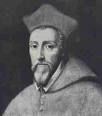



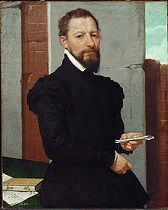





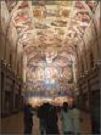
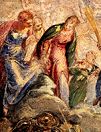
1588 On Feb. 11 Pope Sixtus V issues a bull creating 15 permanent congregations to lessen his work, incl. the Congregation of the Holy Roman and Universal Inquisition or Holy Office - he was expecting an English defeat and a glut of work for the new hires? It's getting to be a habit with me? Another big V for Protestantism? The future of the English is so bright they need to wear shades? In Feb. the Marquis of Santa Cruz dies, and is replaced by Don Juan Alonso Perez de Guzman el Bueno, Duke of Medina-Sidonia (1502-58) as cmdr. of the Invincible Spanish Armada (130 galleon ships carrying 19K-27K men), whose plan is to land in Sandwich-Deal and support an invasion of England through Kent by the Duke of Parma's professional soldiers coming from Flanders (reinforced through the Spanish Road from N Italy), capturing it for the Roman Catholic faith, with exiled English Cardinal William Allen (1522-94) waiting in the wings; it sets sail from Lisbon on May 30, the very day that peace commissioners sent by both sides meet in Parma; after stopping at Corunna for supplies, it sets sail again, then is scattered by a storm from the Bay of Biscay; in early July it leaves La Coruna; on July 19 it is sighted off the The Lizard (Peninsula) by the 197-ship English navy (34 royal warships, 163 armed merchant vessels); on July 21 there is a skirmish off Eddystone, Plymouth, and another on July 23 off Portland, Dorset; on July 27 the Armada anchors off Gravelines between France and Spanish Netherlands to await for communications from Parma's army, the stench from its filthy galleys rowed by slaves chained to their benches carrying for miles on the wind; on Aug. 7-8 (July 28-29 Old Style) (Sun.-Mon.) English "hell-burners" (fire ships) are sent into the 130-ship (22 galleon and 108 armed merchant vessels) Spanish Armada (known for its powerful crescent formation) at the Battle of Gravelines, causing it to break ranks, after which it is defeated by the English guns at close quarters, losing five ships, with the rest badly damaged, and 600 KIA, 800 wounded, and 397 POWs taken; it then makes for Scotland without Parma's army, where it is broken up by a great "Protestant wind" off the coast on July 30, then forced onto the N and W Irish coasts, where 24+ ships are wrecked; the Spanish warship La Girona fires a broadside at the Chimney Tops in the Giant's Causeway on the N coast of Ireland (60 mi. NW of Belfast) after believing them to be an enemy fortress, ending up wrecked on Oct. 26, losing all but nine of 1.3K aboard; on Aug. 19 (Aug. 9 Old Style) glammed and glowing queen (since Nov. 17, 1558) Elizabeth I (1533-1603) rides down to Ft. Tilbury in Essex to cheer up the troops and see the Armada, and rides out with a 6-man bodyguard, giving her big Tilbury Speech while mounted on a grey gelding and dressed in white with a silver cuirass (metal breastplate), with the immortal soundbyte: "I have the body but of a weak and feeble woman, but I have the heart and stomach of a king"; after waiting two more days for a possible invasion by Parma's army from Dunkirk, the English troops disperse and party hearty; meanwhile the remaining 53 intact Spanish ships, having lost two-thirds of their men (15K-20K of the 11K sailors and 19K soldiers) straggle back to Spain by Oct. 14; the English lose eight ships, 50-100 killed, and 400 wounded, although 6K-8K later die of disease; Drake's co-admirals Martin Frobisher and John Hawkins are knighted for their role in the big British V; Elizabeth I hands out medals with the inscription "God breathed and they were scattered"; on Sept. 29 Spanish warship San Esteban is wrecked on the W coast of Ireland, with all survivors killed or taken POW and hanged after reaching shore; 10K English troops were equipped with firearms as an experiment, while the Spanish relied on archers, and the English success convinces military experts to give up on archery; the Armada Portrait of Elizabeth I, by an unknown artist shows her resting her hand on a globe over America; English Roman Catholic Charles Neville, 6th Earl of Westmorland (1542-1601), who commanded a 700-man army of English fugitives from Flanders flees to the Continent, and is attainted by Parliament, living on a small pension from the Spanish king until he dies broke on Nov. 16, 1601; after getting separated from the fleet in July and forced to battle some of England's most powerful ships until putting into port in Ireland, Spanish 2nd in command Adm. Don Juan Martinez de Recalde (1540-88) returns to A Coruna, dying of his wounds on Oct. 23 a few days after docking; British sea supremacy begins, along with increasing nationalism in England, helping secure Protestantism as England's state religion, and being white and not olive-skinned or some other shade of red, brown or black as the metareligion; Spain's officer class is wiped out, the Duke of Medina-Sidonia never recovers from the humiliation, the Duke of Parma's rep. remains under a cloud, but the Spanish keep hoping for a miracle from God to defeat the infidels, sending four more armadas until 1601; the Dutch are greatly helped in their battle for independence from the Spanish, going on to clear them from the territories of the Seven United Provinces by the end of the cent. Big day for the Huguenots and anybody named Lorraine, and a blois year for French Catholics named Guise? In May Henri I de Lorraine, 3rd Duke of Guise (b. 1550) (leader of the Holy League) turns against Henry III, and on May 12 leads the Parisians in revolt on the Day of the Barricades (timed to distract Protestant Huguenots from helping the English fight the Spanish Armada), placing excommunicated Henri IV on the throne; Henry III is allowed to escape to Blois after he makes Lorraine the lt.-gen. of France, but after summoning the Estates-Gen. the pissed-off king engineers the assassination of the Duc de Guise along with his brother Cardinal de Guise on Dec. 23 at Blois; Queen Mother Catherine de' Medici is mad at her son's actions, along with the Estates-Gen. at Blois, who remonstrate strongly about the murders; too bad, Henry III leaves the House of Guise viable, and fails to kill the real troublemaker, the third brother Charles of Lorraine, Duke of Mayenne (Charles de Guise) (1554-1611), who leads a revolt against him, causing him to belatedly try to exterminate the whole house; Philippe de Mornay becomes the sole leader of the French Huguenots, becoming known as the "Huguenot Pope"; in the shuffle, all plans for revenging Mary, Queen of Scot's death are dropped? On Apr. 4 Frederick II (b. 1534) dies, and his son Christian IV (1577-1648) becomes king of Denmark and Norway (until Feb. 28, 1648), going on to rule for almost 60 years, initiate many reforms and projects, and have at least 26 children, legitimate and not - that's Folketing great? On Sept. 4 Leicester dies of stomach cancer, ruining her celebration of Accession Day, which continues this year from Nov. 17 until Nov. 19, St. Elizabeth's Day. In Sept. having seen the defeat of the Spanish Armada, Alessandro Farnese breaks his camp in Dunkirk, and finds that the pesky Dutch Protestant heretics have regrouped. In the fall Duke Charles Emmanuel I of Savoy takes advantage of the civil war in France to occupy the marquisate of Saluzzo. In Oct. Persian hero, prince, and heir apparent Hamzeh Mirza is assassinated, and his 17-y.-o. younger ascetic brother Abbas I the Great (1571-1629) (Abbas Mirza) (ruler of Khorasan since 1581) comes to Qazvin to claim the crown in his brother's name, and Mohammed Khodabanda (d. 1595), who suffers from near blindness personally crowns him as Safavid shah #5 of Persia and resigns after being deposed and imprisoned; Abbas goes on to gain support from the common people, modernize and de-Qazilbash the army with Euro help, secure the borders against the pesky Turkmen tribes and Uzbeks, and make Persia (Iran) a power in the world, with the Persian Gulf opened to trade; in his reign Persian Safavid Art reaches its summit. English ambassador to Russia Giles Fletcher the Elder (1549-1611) reestablishes the treaty with Tsar Feodor I. The Spanish Armada carries a large number of bilboes for restraining English POWs; after getting hold of some, they begin to be used for punishing imaginary or slight offenses in the English colonies. Cardinal Robert Bellarmine becomes spiritual dir. of the Collegio Romano - the flat men? The English Guinea Co. is founded to challenge the Dutch West India Co., but proves ineffective. Corrientes (San Juan de Vera), 25 mi. below the junction of the Parana and Paraguay Rivers in Argentina is founded by the Spanish. The first English paper mill is founded in Dartford. Architecture: The Residenzplatz in Salzburg, Austria is begun on the cemetery of the old monastery N of Salzburg Cathedral, starting with the Renaissance Neue Residenz, featuring a prominent bell tower, becoming the home of the prince-archbishops of Salzburg; in 1656-61 the Baroque Untersberg limestone Residenzbrunnen fountain is built, designed by Tommaso di Garona and topped by a statue of Triton based on the Triton Fountain in Rome, becoming the largest Baroque fountain in Europe. Italian architect Antonio da Ponte (1512-95) begins the stone arch Rialto Bridge over the S-shaped 2-mi. palace-lined Grand Canal in Venice (finished 1591); it goes on to become Venice's top tourist attraction. Domenico Fontana builds the Sistine Hall of the Vatican Library in Rome, which was originally founded in 1447-55 by Nicholas V with a nucleus of 340 vols. Fort Duncannon (Gael. "Dun Conan" = "Fort of Conan") in Duncannon Harbour in County Wexford, Leinster, Ireland is built to withstand the Spanish Armada. Science: Tycho Brahe rejects Copernicus' system, and proposes his own where the Sun, Moon, and fixed stars orbit the stationary Earth, and the five planets orbit the Sun - your future's worth a five minute phone call? Art: Annibale Carracci (1560-1609), Frescoes in Magnani Palace (Bologna). Tintoretto (1518-94), Paradiso (Doge's Palace, Venice) (1588-92); o ne of his last commissions, won after a competition. Music: William Byrd (1540-1623), Psalms, Sonets and Songs of Sadnes and Piete. Nicholas Yonge, Musica Transalpina (London) (57 madrigals). Nonfiction: Jean Bodin (1530-96), Colloquium of the Seven; a Calvinist, a Lutheran, a Jew, a Roman Catholic, a Muslim, and a skeptic debate, finally agreeing to tolerate each other; circulated only in ms. form. Giovanni Botero (1544-1617), On the Causes of Greatness in Cities (Delle Cause Della Grandezza Delle Citta); claims that cities grow when their nutritive virtue is greater than their generative virtue, and vice-versa; mentions the Chinese habit of tea drinking: "The Chinese have an herb from which they press a delicate juice which serves them instead of wine. It also preserves the health and frees them from all those evils that the immoderate use of wine doth breed in us." Timothie Bright, An Arte of Shorte, Swifte, and Secrete Writing by Character; first English shorthand manual. Giordano Bruno (1584-1600), Cause, Principle, and Unity; "I say the universal physical efficient cause is the universal intellect, which is the first and principle faculty of the world soul, which, in turn, is the universal form." Joachim Camerarius, Hortus Medicus. Thomas Hariot (1560-1621), A Briefe and True Report of the New Found Land of Virginia; written after having been sent to the colonies by Sir Walter Raleigh; incl. paintings of the aborigines by Roanoke gov. John White (1540-1618), and the first Map of Virginia; Hariot is the first Englishman to smoke tobacco? Giovanni Pietro Maffei (1533-1603), Historica Indica (Rome); talks about tea drinking in Japan, with the soundbyte: "The Japanese have as yet no use for grapes, but they make a kind of wine from rice. But that which before all they delight to drink is water almost boiling, mingled with the powdered chia." Michel de Montaigne (1533-92), Essais, Vol. III. William Morgan (tr.), The Bible Translated into Welsh. Thomas Stapleton, Tres Thomae. Plays: Robert Greene (1558-92), Pandosto, or Dorastus and Fawnia (romance). Christopher Marlowe (1564-93), Doctor Faustus (The Tragical History of the Life and Death of Doctor Faustus) (tragedy) (1588-93); performed 25x by the Admiral's Men between Oct. 1594 and Oct. 1597; scholar Faust makes a pact with the Devil, allowing him to become invisible and steal from the pope, then finds himself unable to burn his books or repent to God to get the contract annulled, and is carried off by demons; gets Marlowe arrested on blasphemy charges, insuring his fame? Novels: Robert Greene (1558-92), Perimedes the Blacke-Smith. Births: English "City Upon a Hill" Puritan leader John Winthrop (OE "friend's village") (d. 1649) on Jan. 12 in Edwardstone, Suffolk; first gov. of Mass. Bay Colony; father of John Winthrop Jr. (1606-76); educated at Trinity College, Cambridge U.; father of John Winthrop the Younger (1606-76) - the Puritan Nehemiah? English "Leviathan", "nasty, brutish and short" philosopher Thomas Hobbes of Malmesbury (Thomas Hobbs of Malmsbury) (d. 1679) on Apr. 5 in Malmesbury (Wiltshire?); born as rumors of the Spanish Armada cause theologians to pore over the Book of Revelation in an attempt to see that Spain is the Antichrist and that the End of Days is Near, causing his mother to go into premature labor?; "My mother was filled with such fear that she bore twins, me and together with me fear", causing him to think himself excessively timid?, and later write the soundbyte: "The original of great and lasting societies consisted not in mutual good will men had toward each other, but in the mutual fear they had of each other"; educated at Hertford College, Oxford U.; breaks English philosophy from scholasticism and founds scientific sociology, ethics, and politics. English Cavalier poet-hymnodist George Wither (d. 1667) on June 11 in Bentworth (near Alton); educated at Magdalen College, Oxford U. French philosopher-naturalist-mathematician and musical theorist Marin Mersenne (d. 1648) on Sept. 8. English composer-singer-lutenist-painter Nicholas Lanier (Laniere) (d. 1666) on Sept. 10 in Greenwich. Mongol khan (1603-34) Ligdan Khutugtu Khan (d. 1634) in Sira Moren Valley. English (Welsh) bishop of Bristol (1644-5) Thomas Howell (d. 1650) in Llangamarch, Brenockshire, Wales; son of a Welsh clergyman; brother of James Howell (1594-1666); educated at Jesus College, Oxford U. English royalist gen. William Seymour, 2nd Duke of Somerset (d. 1660); son of Edward, Lord Beauchamp (1561-1612); grandson of Edward Seymour, 1st earl of Hertford (1539-1621) and Catherine Grey (1640-68); husband of Arbella Stewart (1575-1615). English Puritan Mass. gov. (1629-) John Endicott (Endecott) (d. 1665) in Chagford?; other first gov. of Mass. Bay Colony. Deaths: Ottoman chief architect Mimar Sinan (b. 1489); designed 476 bldgs. incl. 360 monuments - bring your Turkish towel but don't fall for the soap trick? Spanish physician-botanist Nicolas Monardes (b. 1493) on Oct. 10 in Seville (cerebral hemorrhage). Spanish mystic poet Luis de Granada (b. 1505) in Lisbon. French pot Jean Dorat (b. 1508) on Nov. 1. Italian philosopher Bernardino Telesio (b. 1509) on Oct. 2 in Cosenza. Dutch occultist writer Johann Weyer (b. 1515) on Feb. 24 in Tecklenburg. Spanish adm. Alvaro de Bazan, 1st marquis of Santa Cruz (b. 1526) on Feb. 9 in Lisbon, Portugal; Philip II's anger at his independent judgment hastens his death? Italian painter Paolo Veronese (b. 1528) on Apr. 19 in Venice. Spanish physician Juan Huarte de San Juan (b. 1529) in Linares. Spanish painter Alonzo Sanchez Coello (b. 1531) on Aug. 8 in Madrid. English queenly beau Robert Dudley, 1st earl of Leicester (b. 1532); dies after the Spanish Armada is defeated, ruining her victory celebrations? French artist-explorer Jacques Le Moyne (b. 1533). Danish-Norwegian king (1559-88) Frederick II (b. 1534) on Apr. 4. Spanish adm. (2nd in command of the Spanish Armada) Juan Martinez de Recalde (b. 1540) on Oct. 23 in A Coruna, Spain (fever and battle wounds). French gen.-statesman Henri de Lorraine, 3rd Duc de Guise (b. 1550).







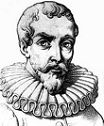




1589 On Jan. 14 Anglican clergyman (Corpus Christi College, Cambridge U. grad) Francis Kett (b. 1547) is burned in the ditch of Norwich Castle for Arian heresy and for claiming that the Jews would one day return to their Promised Land, "leaping and dancing... clapping his hands... until the fire had consumed all his nether parts, and until he was stifled with the smoke." In July the Oxford Executions of Roman Catholics take place, followed by priest-catching and other Catholic persecution in England. The French House of Valois lasts a year of years, less a hundred and four, because its value wa' gone? On Aug. 1 after French king (since May 30, 1574) Henry III (b. 1551) flees to the camp of Calvinist Huguenot Henry of Navarre in Saint-Cloud (St. Cloud) outside Paris for protection, he is murdered while in council by fanatical Dominican monk Jacques Clement (Clément) (b. 1567), who claims to be delivering a secret letter, then stabs him in the stomach, after which the king's attendants immediately kill him (Jesuit intrigue is alleged), and he dies on Aug. 2; three days earlier the king told his attendants that he dreamed of the royal regalia, his blue cloak, two crowns, scepter, sword, and spurs all trodden underfoot by monks and the mob; on his deathbed he names his distant cousin Henry of Navarre as his successor, and on Aug. 4 he is crowned Henri (Henry) IV (1533-1610) of France (until May 14, 1610), ending the Valois Dynasty (founded 1328) after 261 years, and founding the Bourbon Dynasty in France (ends 1830), becoming known as "Father and Friend of the People"; meanwhile on Aug. 2 the Catholic League refuses to recognize him and proclaims old fart Cardinal Charles de Bourbon (imprisoned by Henry since last Dec. 23) as French king Charles X (1523-90) (until May 9, 1590), striking coins in his name in 15 mints inc. Paris, after which parliament recognizes him on Nov. 21, causing Henri IV's enemies to split into two camps, the more patriotic and the more Catholic; Alessandro Farnese is ordered to leave the Low Countries for France to fight against Henri IV; on Sept. 15-18 Henri IV, supported by marshal Armand Louis de Gontaut, Baron de Biron (1524-92) defeats his arch-enemy, the fat Charles of Lorraine, Duke of Mayenne (1554-1611) at the Battle of Arques - now all Henri IV has to do to end 37 years of religious civil war is become a Catholic (1593) and issue the Edict of Nantes (1598)? On Aug. 20 after rejecting 31-y.-o. Katherine of Navarre, 23-y.-o. stylish learned stud and heartthrob James VI (1566-1625) of Scotland marries 15-y.-o. Lutheran Anne (Anna) of Denmark (1574-1619) (daughter of Frederick II and Sophia and older sister of future king Christian IV) by proxy at Kronborg Castle in Denmark, then after her flotilla gets bogged down in Norway he can't wait and sails to Norway, meets her on Nov. 19 and marries her again, spends the winter honeymooning at the Danish court, then proceeds to give her nine children, most not surviving infancy; they speak to each other in their only common language, French. Sir Francis Drake and Sir John Hawkins begin an expedition to seize Philip II's colonial treasure to prevent any more Spanish Armadas, and attack Lisbon with 150 ships and 18K men, but fail to take it. The English House of Commons appoints its first Standing Committee for Privileges. Roman Catholic lords of Scotland supporting the Earl of Huntly battle the king's troops at the Battle of Brig o'Dee road bridge over the Dee River (built 1527) near Aberdeen and lose; since Huntly doesn't show up in person, and is married to the king's kinswoman Henrietta Stewart, he is forgiven and sent home for a few mo., pissing off the Scottish churchmen, who want all Catholic nobles exiled from Scotland. The city of Hyderabad in Golconda, India, 400 mi. SE of Bombay (modern-day pop. 6.8M/7.7M) is founded by Kutb Shahi king Mohammed Kuli as the capital. Boris Godunov's Moscow patriarchate establishes itself as separate and independent from Constantinople. The city of Volgograd (originally Tsaritsyn) is founded at the confluence of the Tsaritsa and Volga Rivers near the unstable S border of Russia; in 1925-61 it is renamed Stalingrad, becoming the scene of the surrender of the German Sixth Army in WWII after the largest and bloodiest battle in history (until ?); in 1961 it is renamed Volgograd. Forks are used for the first time at the French court. After Italian astronomer Guidobaldo del Monte, Marquis del Monte (1545-1607) is wowed by his essay on hydrostatic balance, and commends him to his brother Cardinal del Monte, who refers him to Ferdinando I de' Medici, duke of Tuscany, Galileo Galilei gets a job as prof. of math. at the U. of Pisa; in 1592 Guidobaldo intervenes again in getting him math. chair at the U. of Padua over the opposition of Giovanni de' Medici, son of Cosimo I - making him the Jolly Greek Giant of Science? Francois de Malherbe (1555-1628) becomes court poet to Henri IV, going on to fight Romanticism and the luxuriant style of the Pleiade poets, and restore simplicity, restraint, euphony and exactness to French poetry and prose, going on to make the Parisian dialect the French standard - it's so good to wake up to you? Kiev Academy is founded as a Russian Orthodox copy of a Jesuit college. The Carracci family founds the Accademia degli Incamminati (Academy of Those on the Right Road) to teach their eclectic painting style, employing live models, dissection, plaster casts etc. Sir Walter Raleigh gives up colonizing efforts in Virginia and plants the first potatoes in Europe in Youghal, County Cork, Ireland, first smoking Am. tobacco there - like wow? Inventions: William Lee (1563-1614) of Calverton (near Nottingham) invents the Stocking Frame, the first hosiery-knitting machine; too bad, despite demonstrating it for Elizabeth I, the govt. won't issue a patent for fear of putting manual laborers out of work; he dies in Paris after James I refuses a patent also, and it doesn't become commercially successful until Jedediah Strutt introduces the Derby Rib in 1758 - Leonardo da Vinci missed one? Pineau des Charents fortified aperitif wine is accidentally discovered after an apprentice winemaker in the Charente dept. of SW France (part of the Cognac region) adds grape must to a barrel he believed to be empty but which contained eau de vie (cognac), and is allowed to age for a few years. Music: Thoinot Arbeau (1519-95), Orchesographie; treatise on dancing, with dance tunes. William Byrd (1540-1623), Songes of Sundrie Natures. Nonfiction: Amador Arrais, Dialogues de Dom Frei Amador Arraiz. Caesar Baronius (1538-1607), Martyrologium Romanum (Rome). Thomas Blundeville (1522-1606), Briefe Description of Universal Mappes and Cardes; pub. his invention of the protractor. Giovanni Botero (1544-1617), The Reason of State (Della Ragion di Stato); disses Machiaveli's "The Prince", claiming that a prince must base his power on some form of consent of his subjects, and not only seem but be just. Giordano Bruno (1548-1600), De Magia (On Magic); De Vinculis In Genere (A General Account of Bonding); all pub. in Germany and dedicated to his secy. Girolamo Besler. Alberico Gentili (1552-1608), De Jure Belli (On the Law of War) (3 vols.); his main work on public internat. law; dedicated to the earl of Essex. Richard Hakluyt (1552-1616), The Principall Navigations and Discoveries of the English Nation. Justus Lipsius, Politicorum sive Civilis Doctrinae. Giovanni Antonio Magini (1555-1617), Novae Coelestium Orbium Theoricae Congruentes cum Observationibus Nicolas Copernici (New Theories of the Celestial Orbs Agreeing with the Observations of Copernicus) (Venice); his geocentric system of 11 rotating spheres. Giovanni Mazza, Map of Asia. Thomas Nashe (1567-1601), Anatomie of Absurdities; criticism of contemporary lit.; "There be three things which are wont to slack young Students endeavour, Negligence, want of Wisedome, and Fortune"; "Our learning ought to be our lives amendment, and the fruits of our private studie ought to appeare in our public behavior". Giambattista della Porta (1535-1615), Phytognomonica; expounds the doctrine of Signatures in Nature. George Puttenham (-1590), The Arte of English Poesie. Pontus de Tyard (1521-1605), Discours philosophiques. Plays: Thomas Kyd (1558-94), The Spanish Tragedy; or, Hieronimo is Mad Againe; the most popular Elizabethan play, and the first English revenge play, featuring a play within a play, copied by Shakespeare in Hamlet. William Shakespeare (1564-1616), The Two Gentlemen of Verona (1589-91) (comedy); his first play, showing that he's not ready to handle scenes with more than four characters?; smallest cast of any Shakespeare play, and first in which the heroine (Julia) dresses as a boy; borrows from Jorge de Montemayor's 1559 romance "Diana Enamorada", and John Lyly's 1589 play "Midas"; not performed until 1762; first of three plays (The Taming of the Shrew, Romeo and Juliet) set in Verona on the Adige River in N Italy, known for its humid subtropical climate; Valentine, his clownish servant Speed and babe Silvia (daughter of the duke of Milan); friend Proteus, whose servant is Launce (whose dog is Crab), and who jilts his babe Julia (whose maid is Lucetta) for Sylvia, and gets Valentine banished so he can close in; meanwhile foolish Thurio has been chosen for Sylvia by her daddy, and closes in on her, while pissed-off Julia dresses in drag and becomes Proteus' page Sebastian to win him back, after which Proteus tries in vain to woo Silvia, and finally tries to rape her, but she is saved by Valentine, who then turns around and gives her to him for friendship's sake, causing Julia to faint, give her identity away, and cause Proteus to suddenly fall in love with her, allowing Valentine to marry Silvia; "To be in love, where scorn is bought with groans" (Valentine) (1.1.30); "I have no other, but a woman's reason;/ I think him so because I think him so" (1.2.23-4) (Lucetta); "They do not love that do not show their love. (Julia)/ O! they love least that let men know their love (Lucetta)" (1.2.31); "Though ne'er so black, say they have angels' faces./ That man that hath a tongue, I say, is no man,/ If with his tongue he cannot win a woman" (3.1.103-4) (Valentine); "Nay then, the wanton lies; my face is black" (Thurio)/ "But pearls are fair, and the old saying is,/ Black men are pearls in beauteous ladies' eyes" (Proteus)/ 'Tis true, such pearls as put out ladies' eyes;/ For I had rather wink than look on them" (5.2.10-14) (Julia). William Shakespeare (1564-1616), Henry VI, Pt. 1 (1589-90) (history); based on Raphael Holinshed's "Chronicles"; the first appearance of Sir John Falstaff, who flees a battle to save his skin; portrays La Pucelle (Joan of Arc) as a witch whore; Henry VI; Duke Humphrey of Gloucester, Duke John of Bedford, Duke Thomas Beaufort of Exeter, Cardinal Henry Beaufort, bishop of Winchester, John Beaufort, 1st duke of Somerset, Duke Richard Plantagenet of York, Richard de Beauchamp, 13th earl of Warwick, Thomas Montagu, 4th earl of Salisbury, John Talbot, 1st earl of Shrewsbury, John Talbot, 1st viscount Lisle, Edmund Mortimer, 5th earl of March; Poetry: Robert Greene (1558-92), Menaphon: Sephesta's Song to Her Child; written in imitation of Philip Sidney's "Acadia"; "Weep not, my wanton, smile upon my knee,/ When thou art old there's grief enough for thee". Thomas Lodge (1558-1625), Scillaes Metamorphosis; pub. in 1610 under the title "Glaucus and Scilla"; sea god Glaucus' courtship of nymph Scilla, who is cruel to him, causing him to turn her into a lonely rock in the sea; first romantic treatment of a classical subject in English verse?; "He hath seene the sweete Arcadian boy/ Wiping the purple from his forced wound." George Puttenham (-1590), The Art of Poesie. Deaths: German humanist educator Johannes Sturm (b. 1507) on Mar. 3 in Strasbourg. English surveyor-gen. of Ireland (1559-89) Sir Valentine Browne (b. 1510) in Feb. French Huguenot potter Bernard de Palissy (b. 1510) in the Bastille, where he was imprisoned for his religion in 1588 after being betrayed by a fellow Huguenot. French queen mother ("Madame La Serpente") Catherine de' Medici (b. 1519) on Jan. 5 in Chateau de Blois (pleurisy). French printer Christophe Plantin (b. 1520) on July 1 in Amsterdam; printed 1,863 different book eds. in a printing plant with 22 presses and 160 workers. English statesman Sir Walter Mildmay (b. 1523) on May 31 in Apethorpe, Northamptonshire. German prince of Brunswick-Wolfenbuttel (1568-89) Julius, duke of Brunswick-Luneburg (b. 1528) on May 3 in Wolfenbuttel. Italian-born French poet Jean-Antoine de Baif (b. 1532) on Sept. 19 in Paris. French last Valois king (1574-89) Henry III (b. 1551) on Aug. 2 in Paris (murdered).